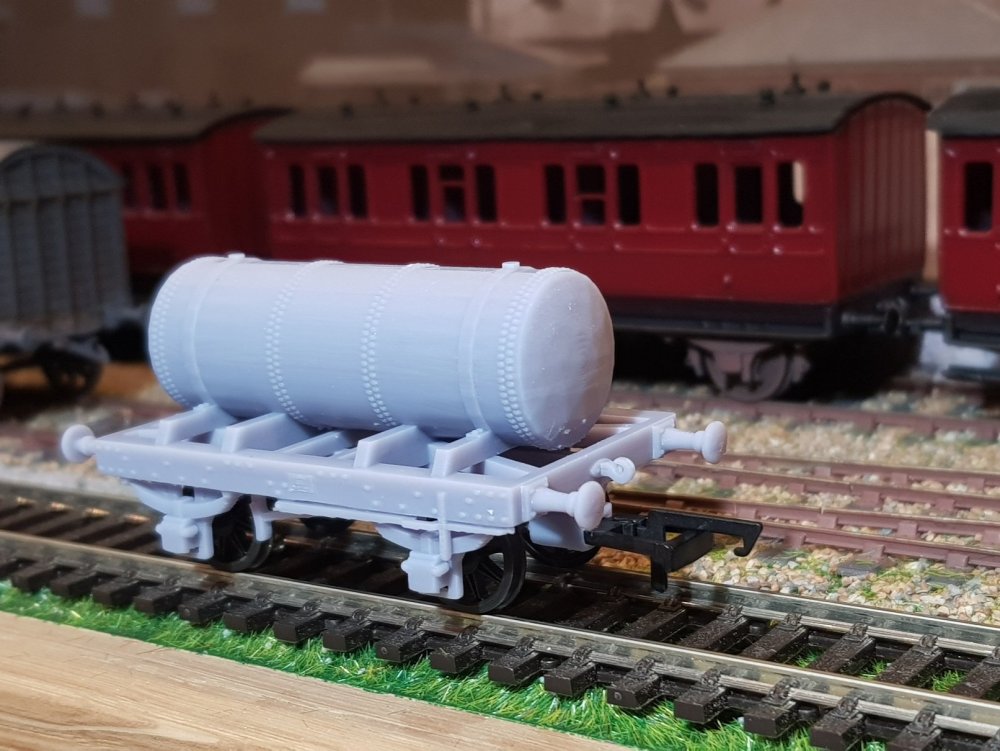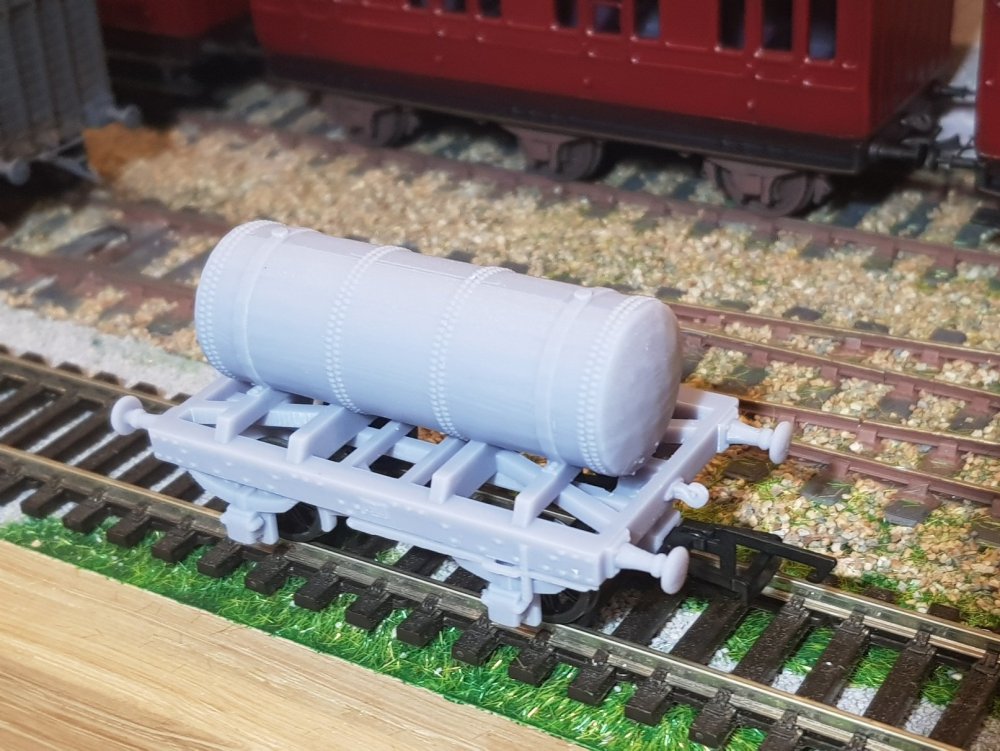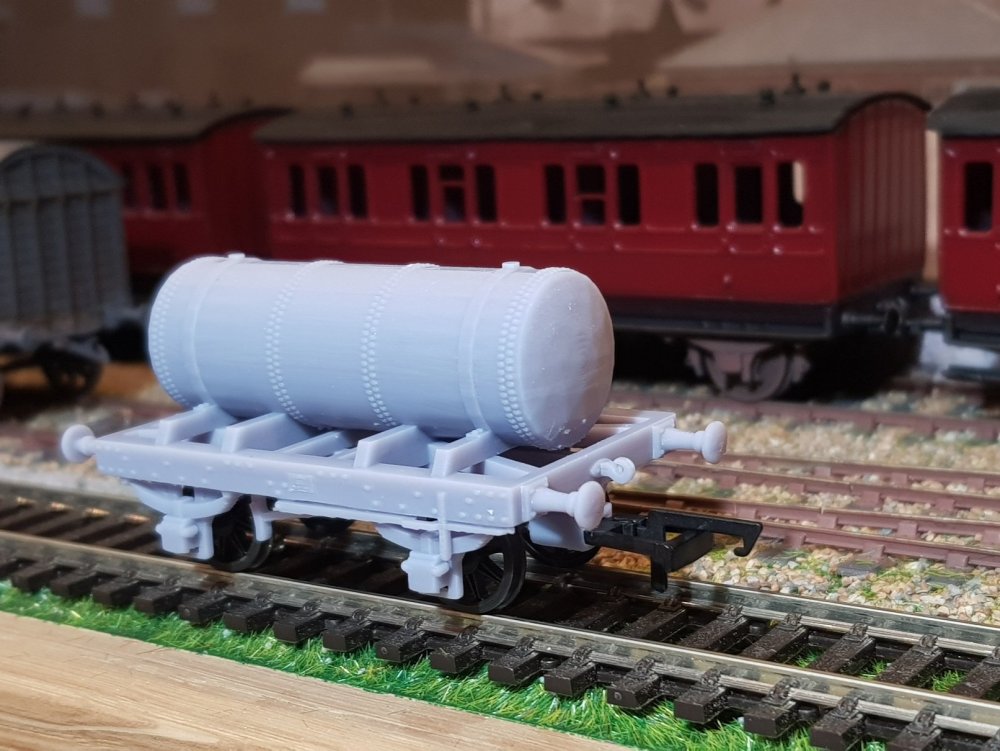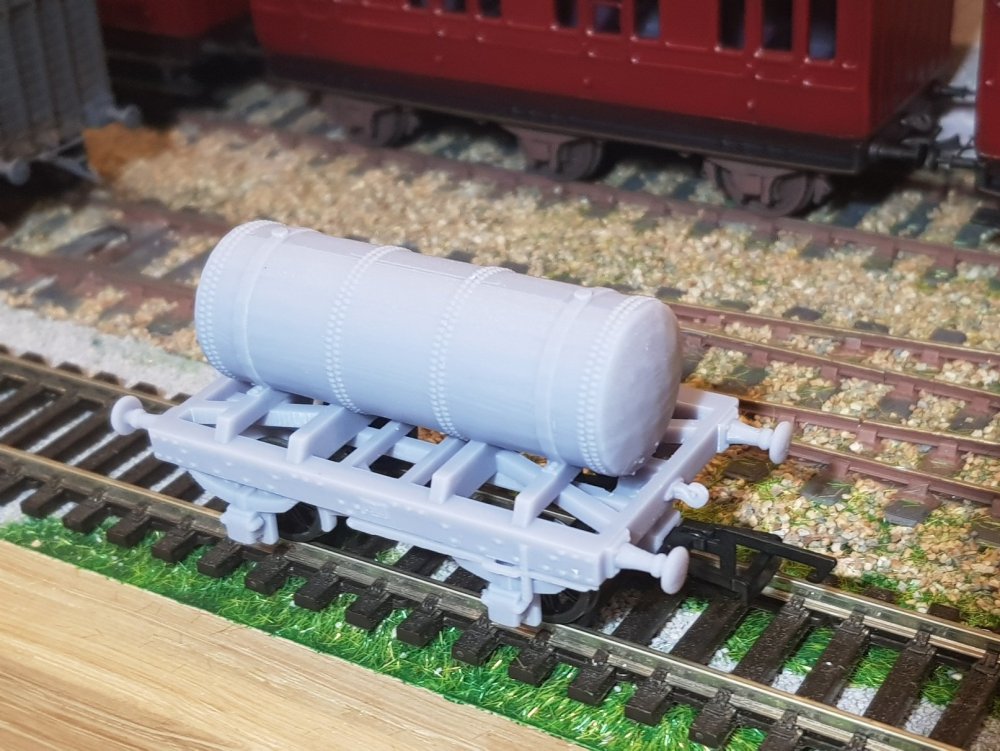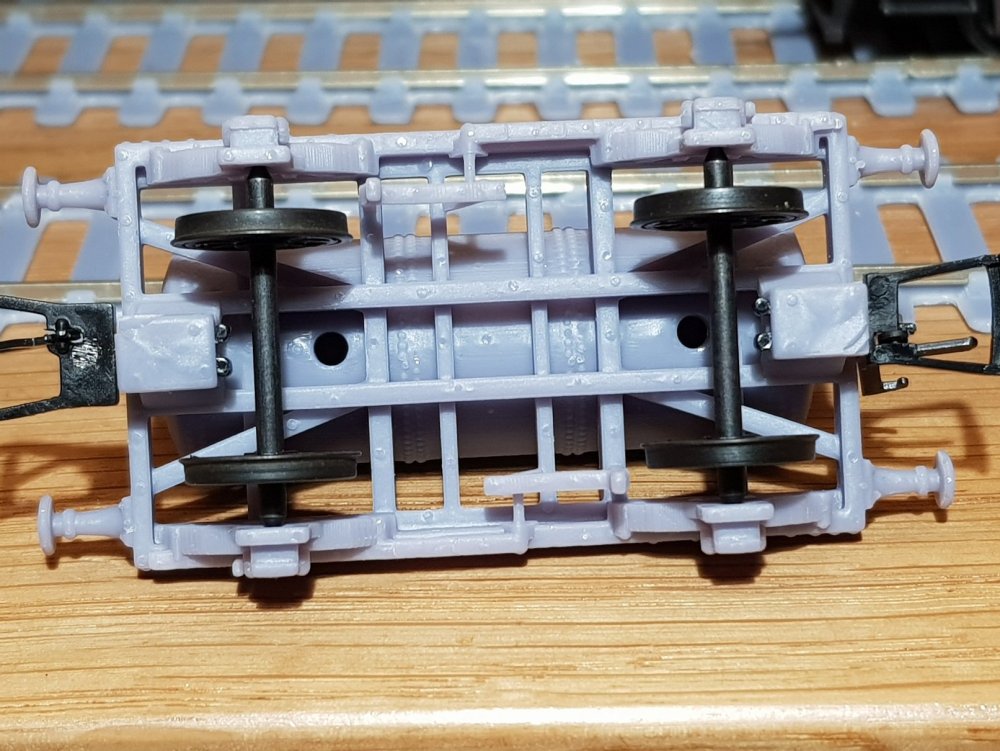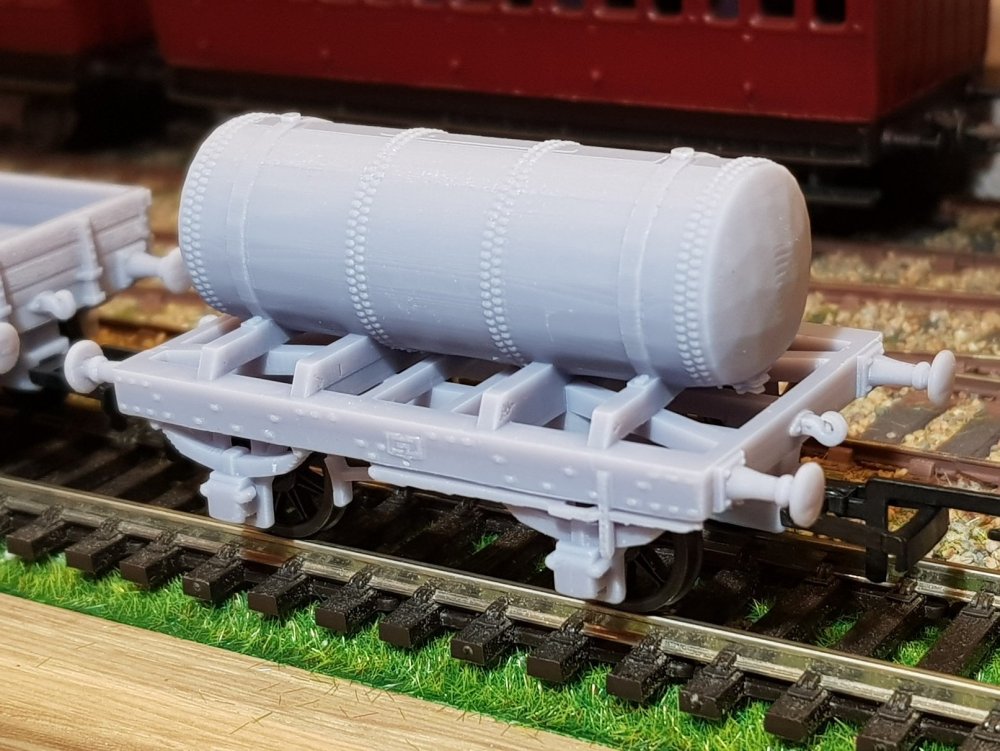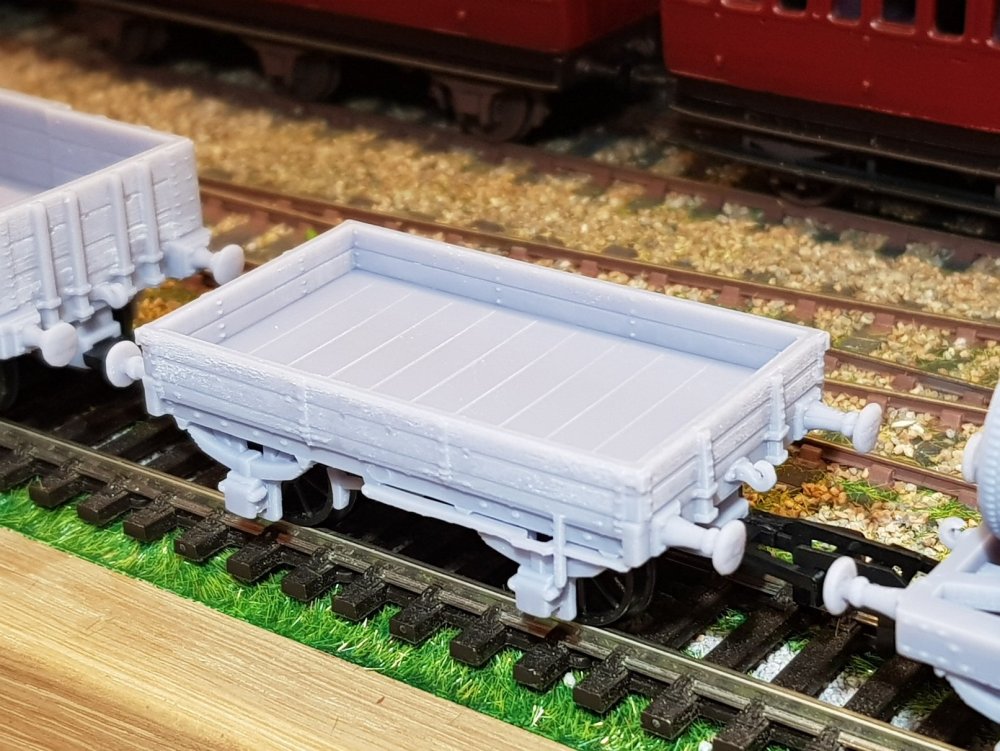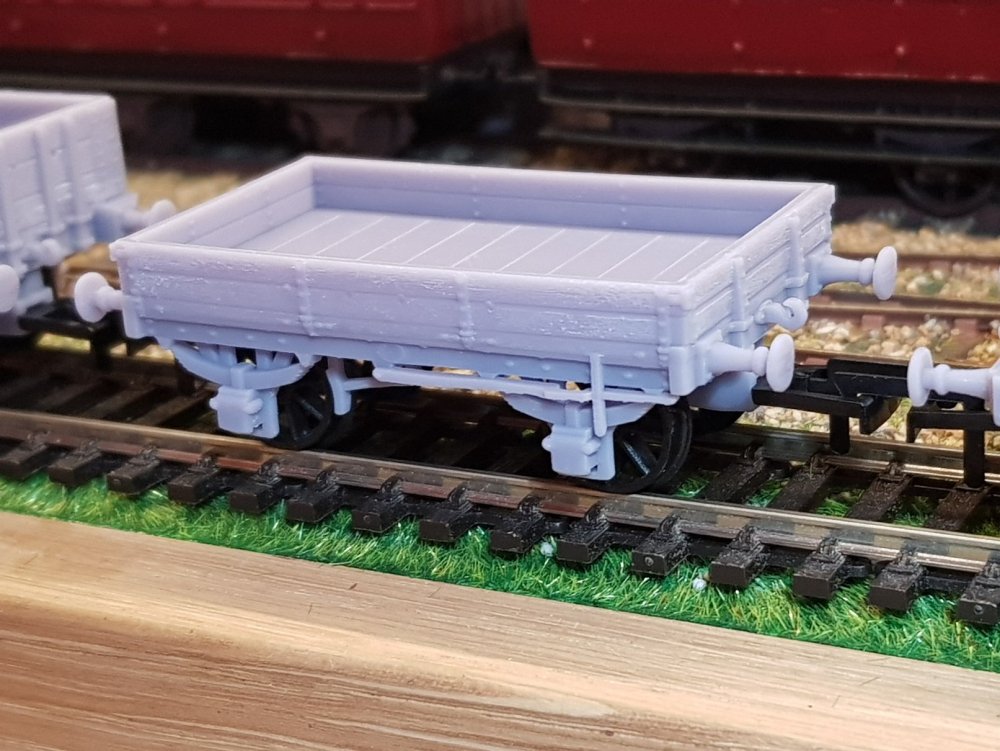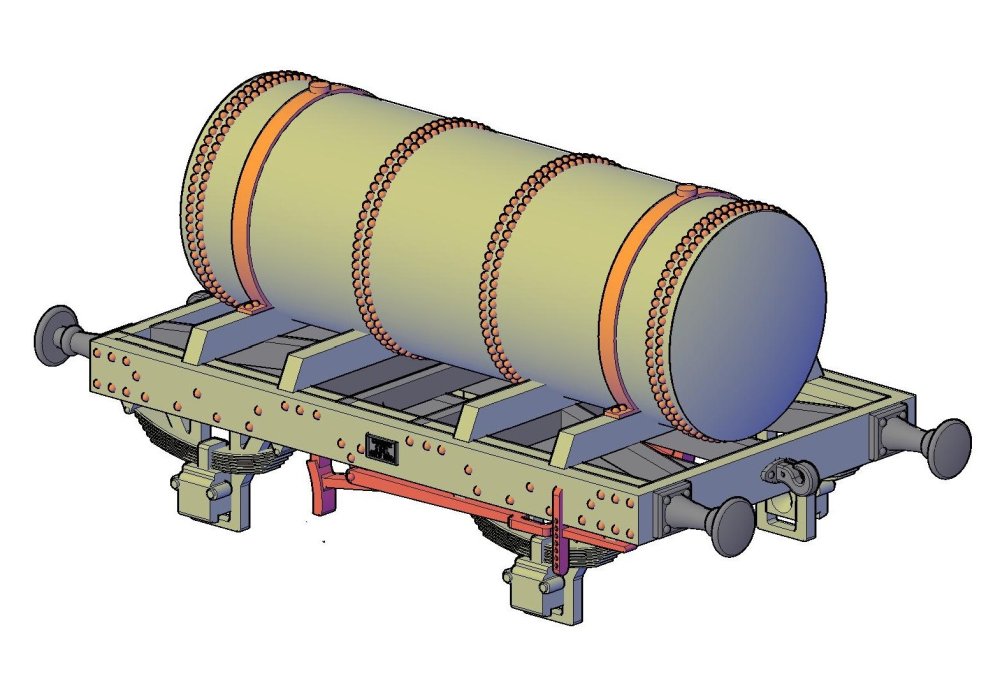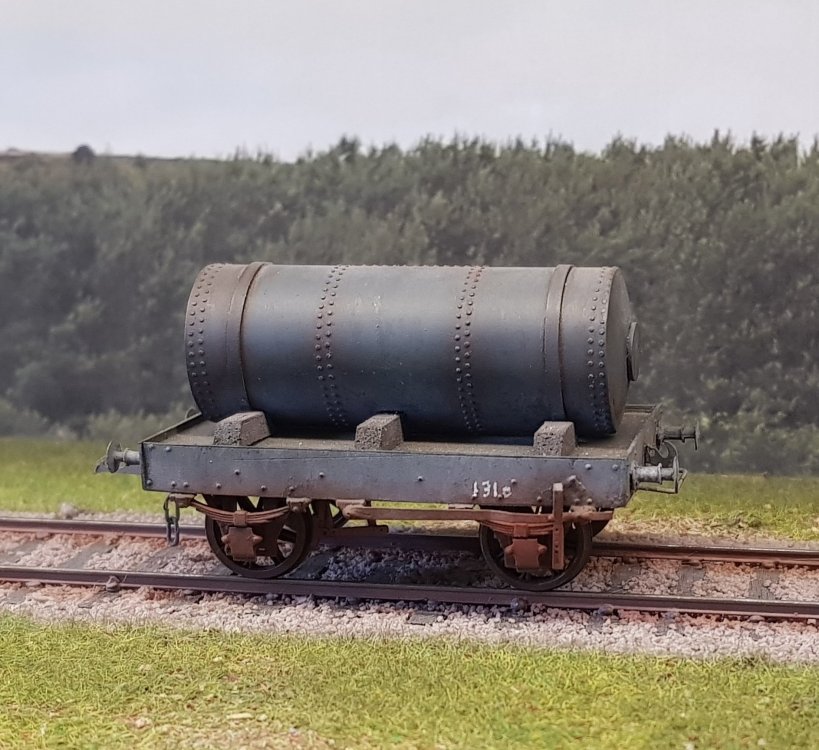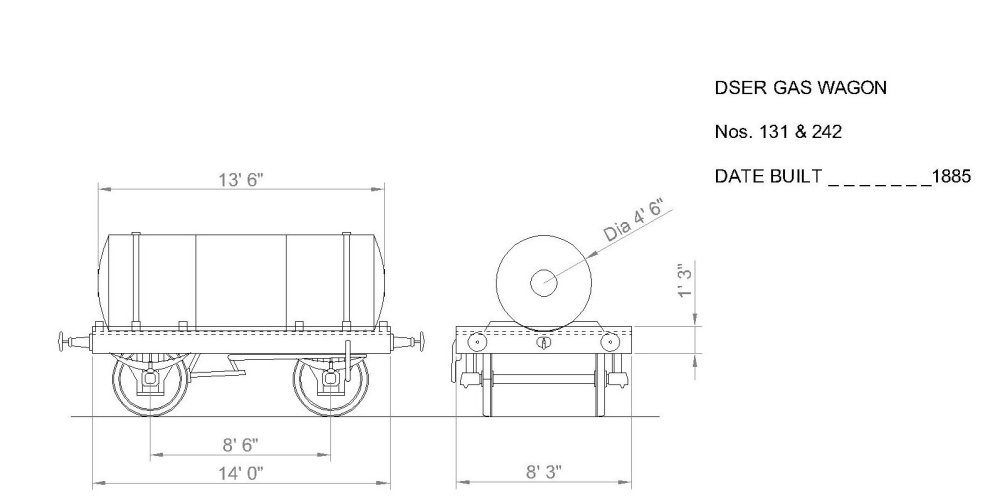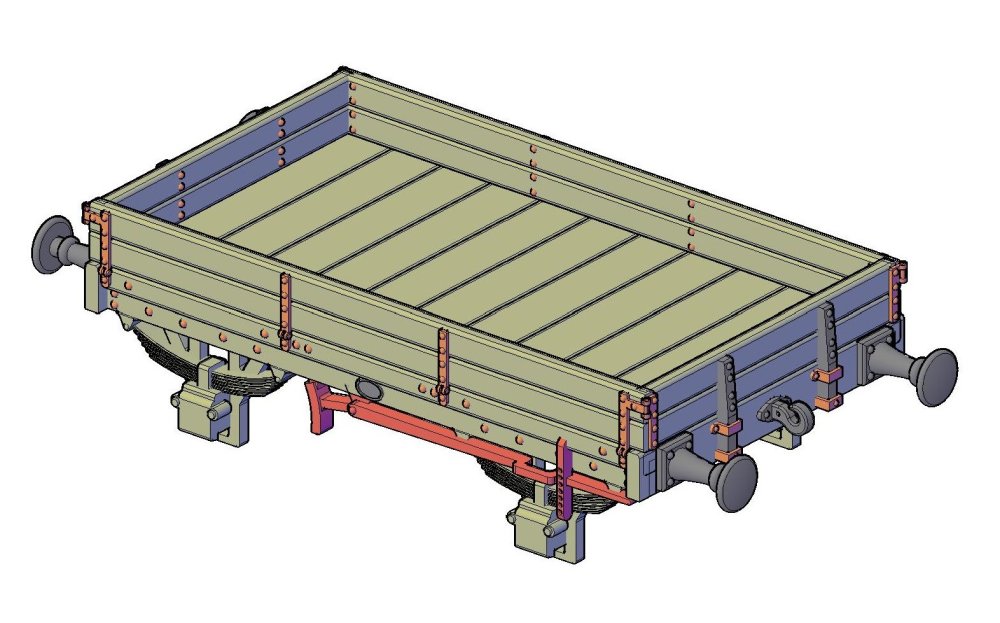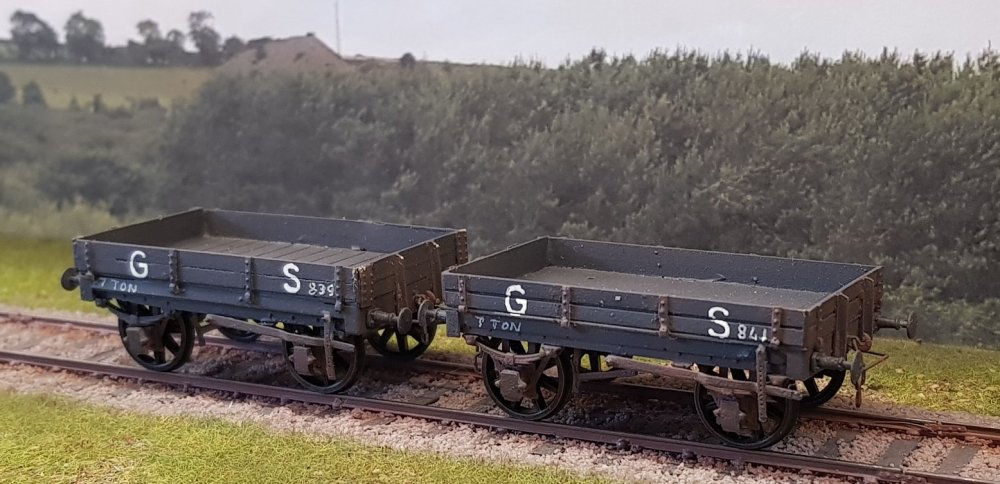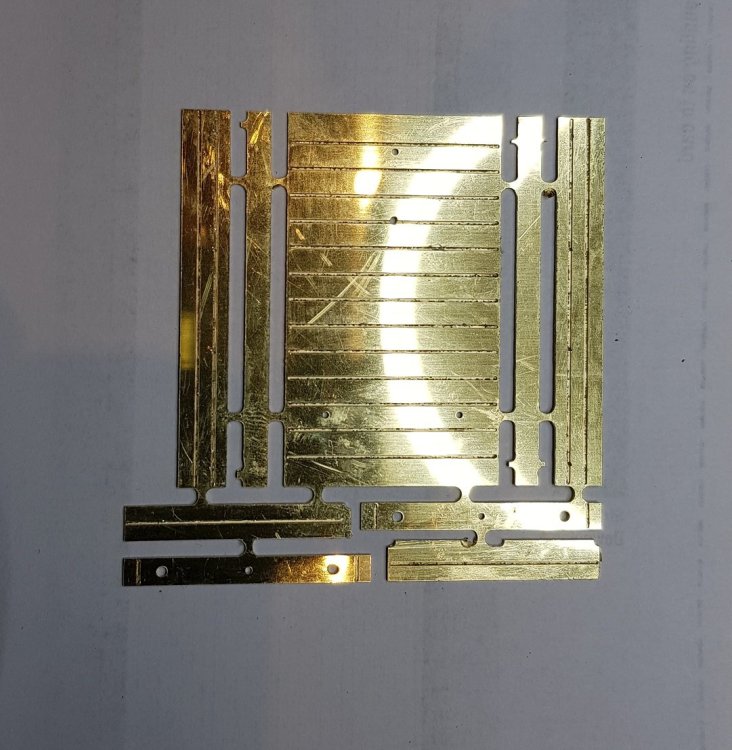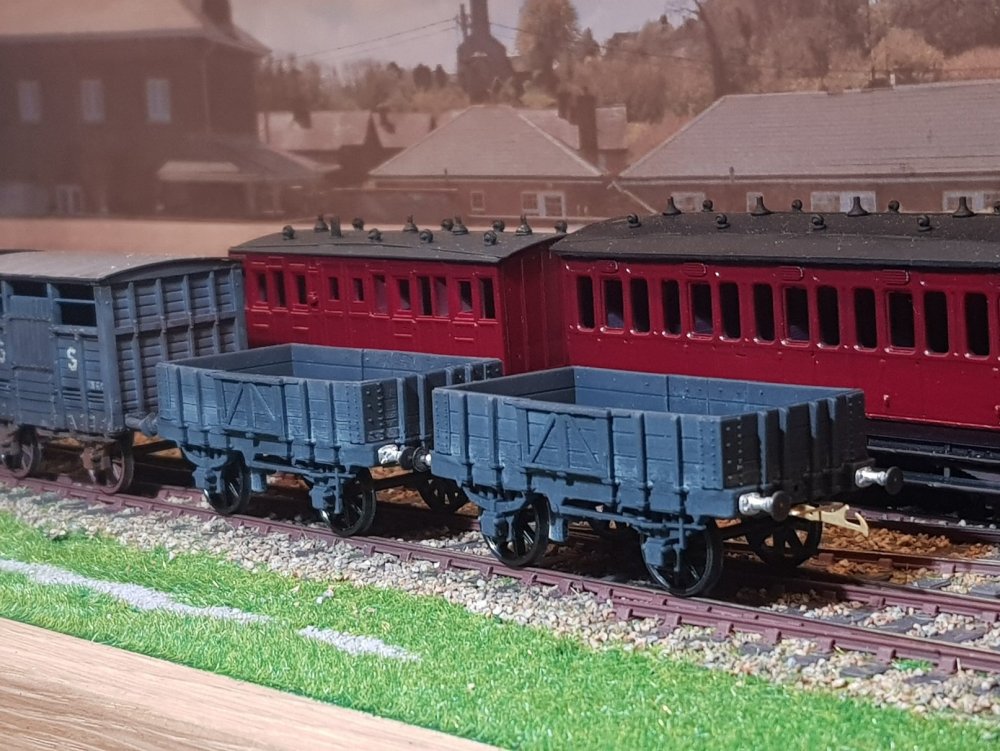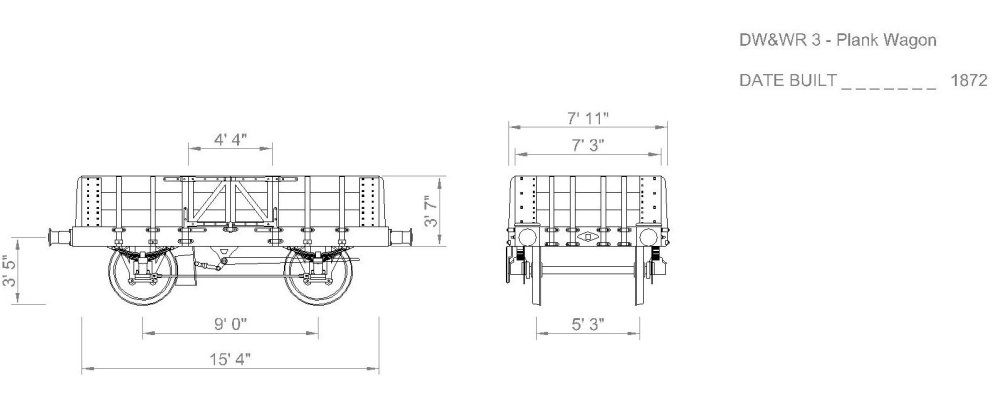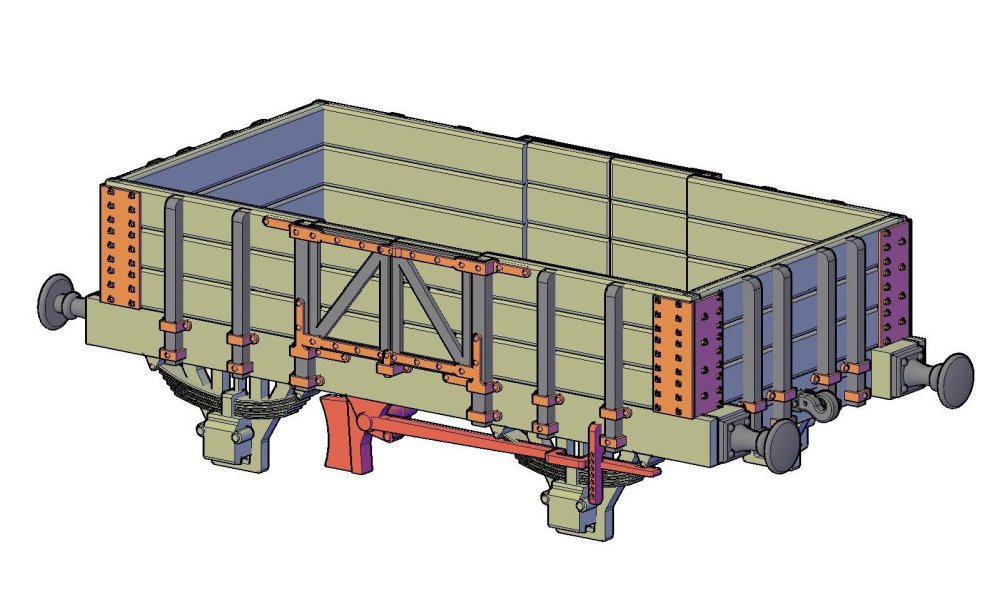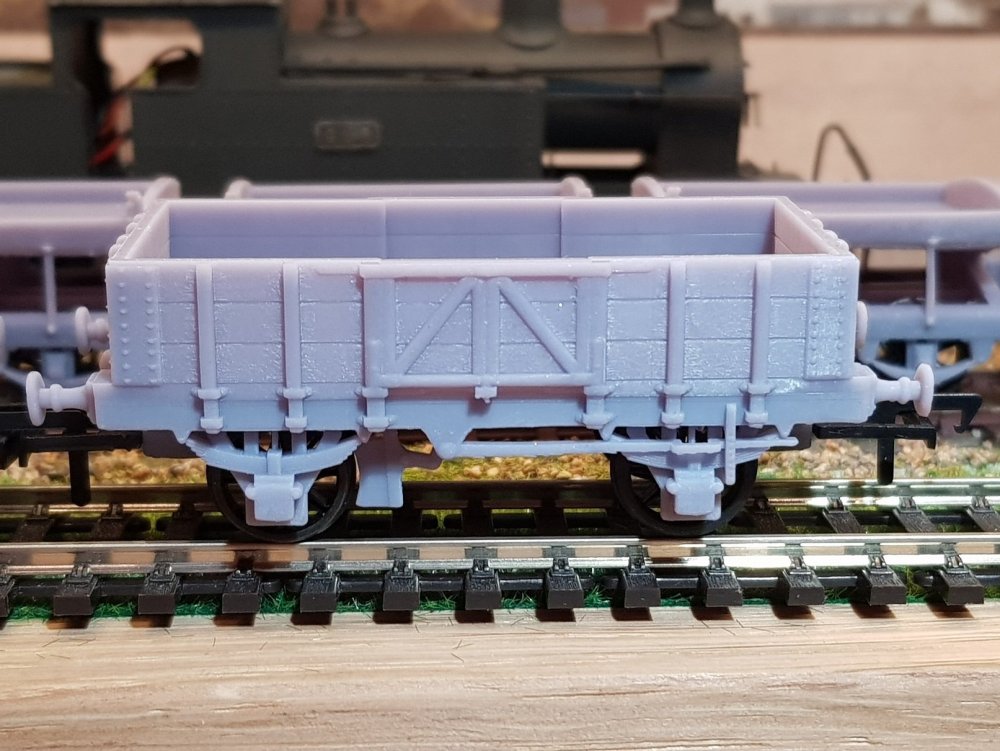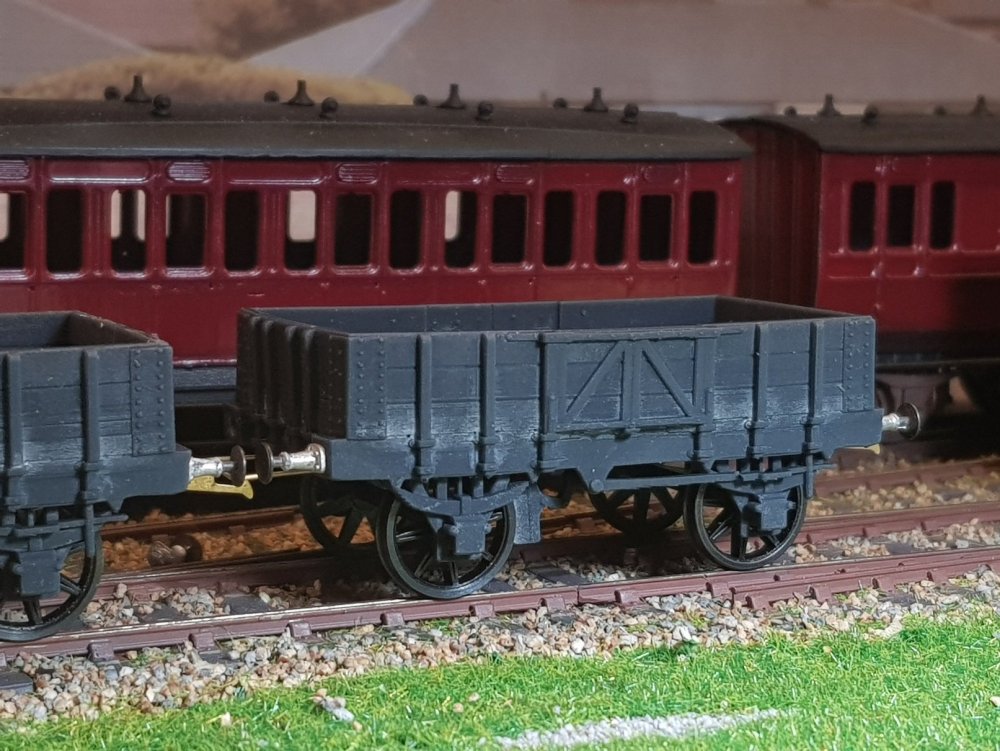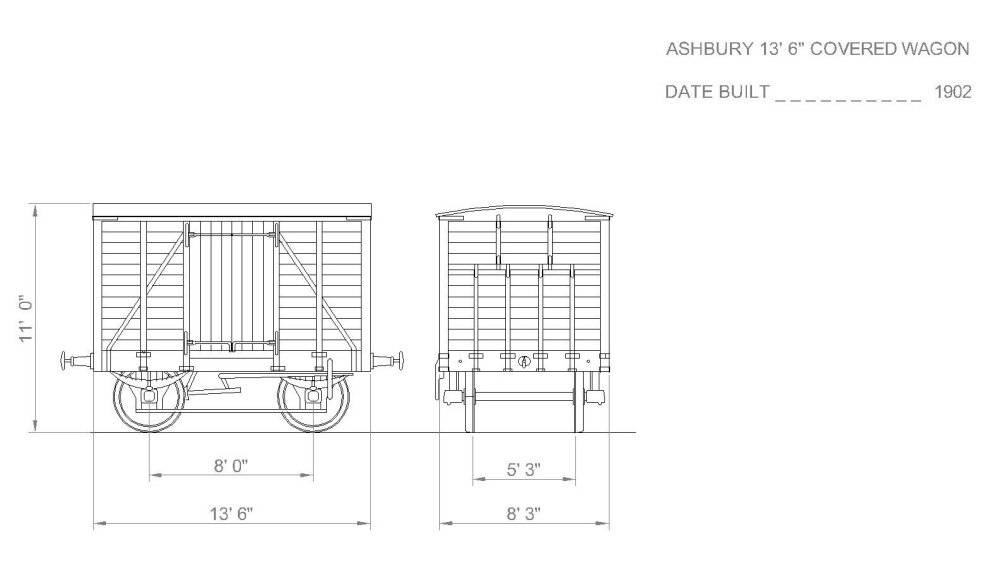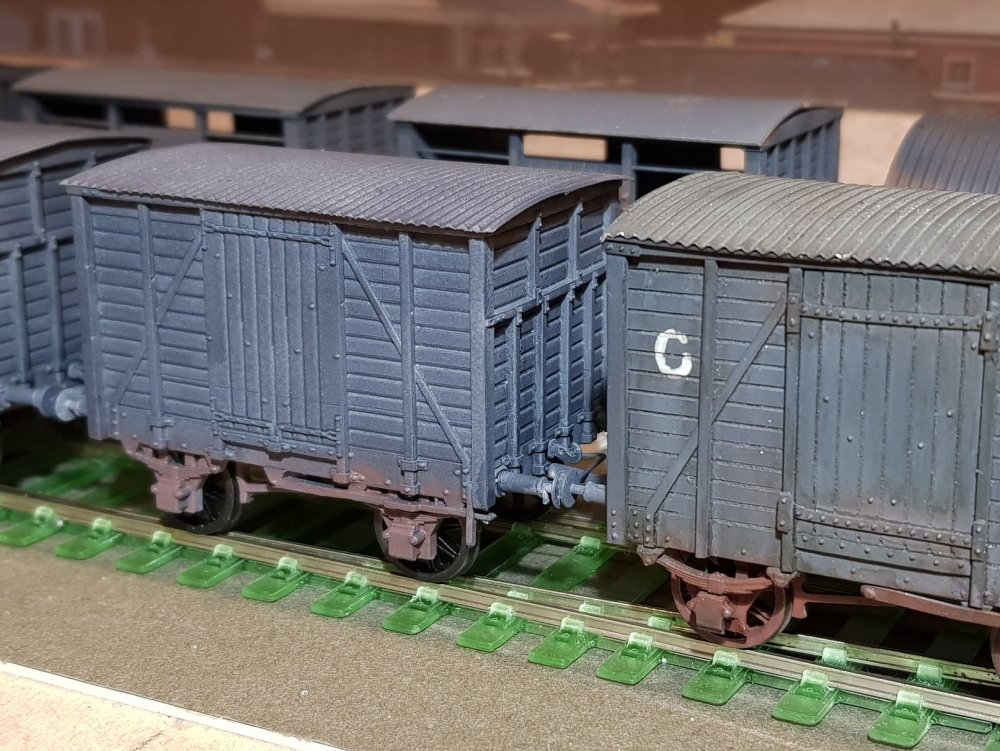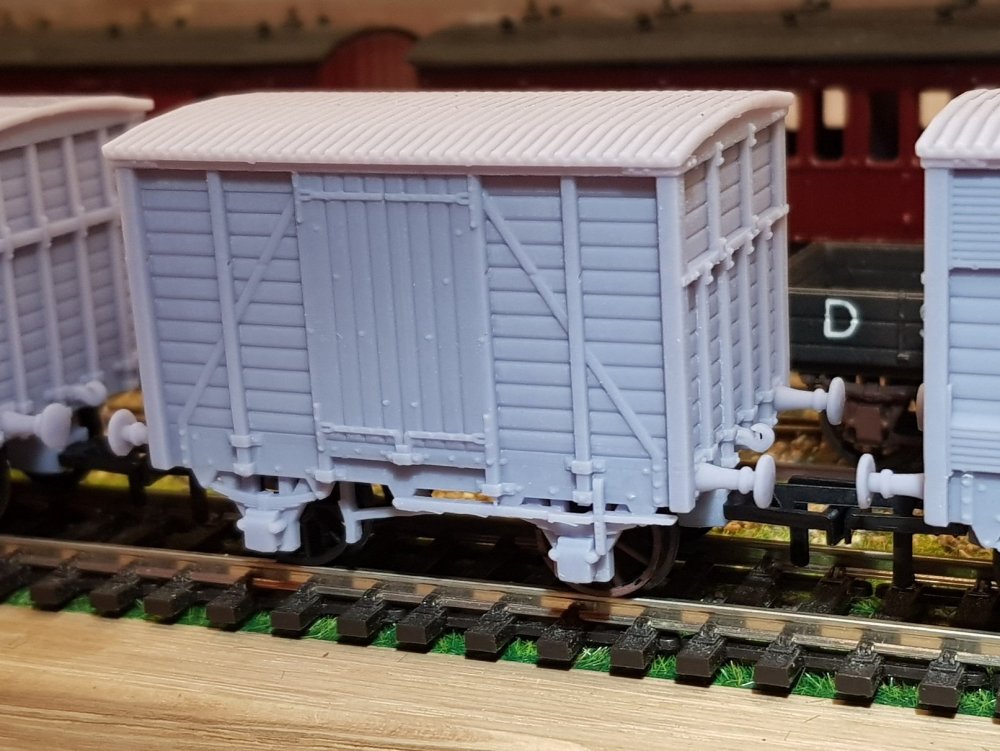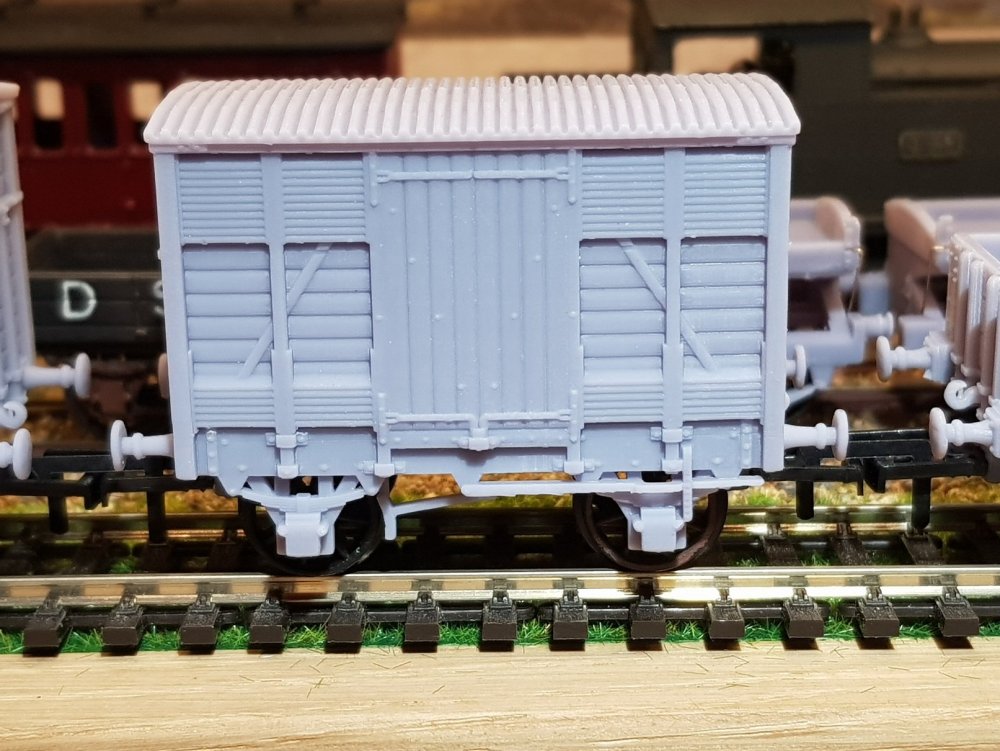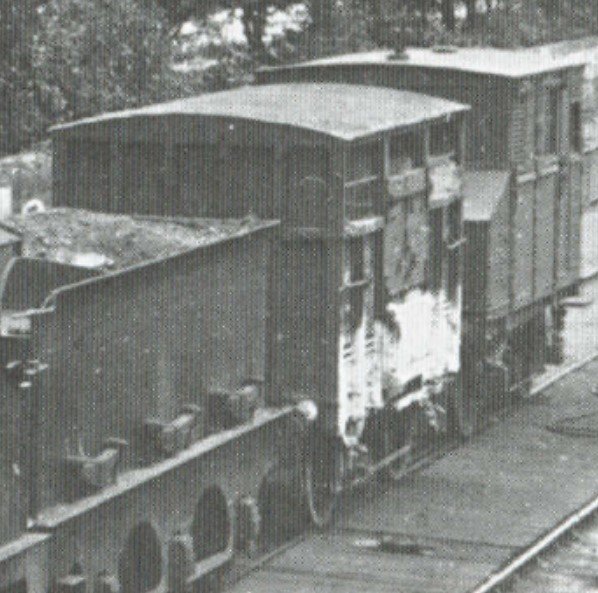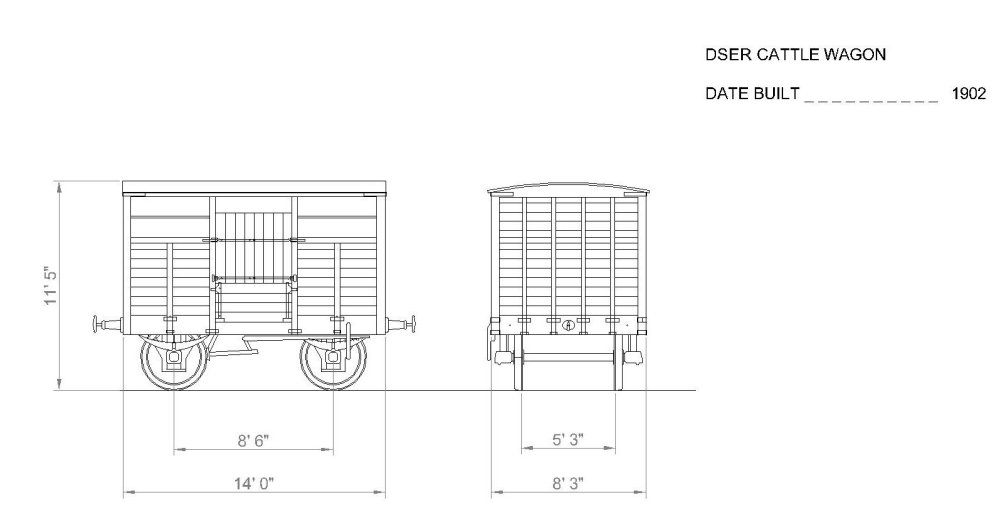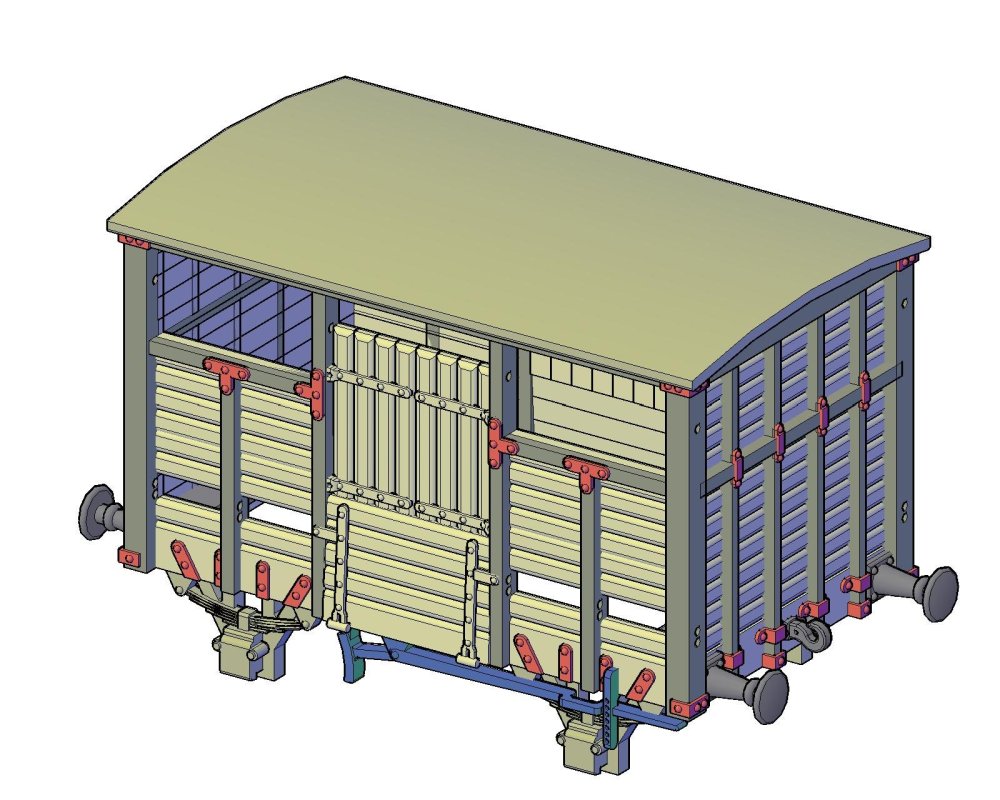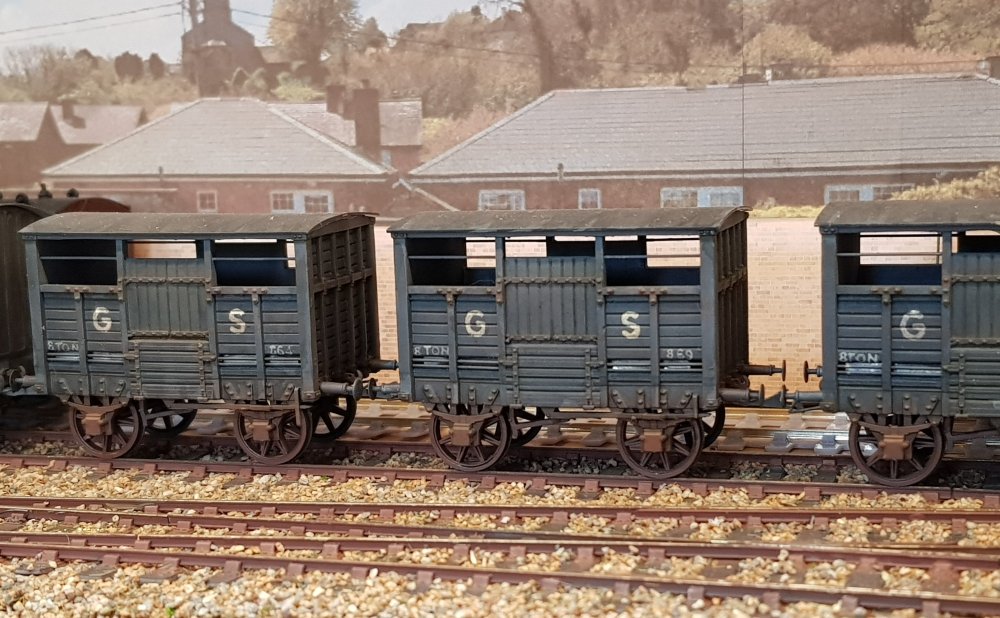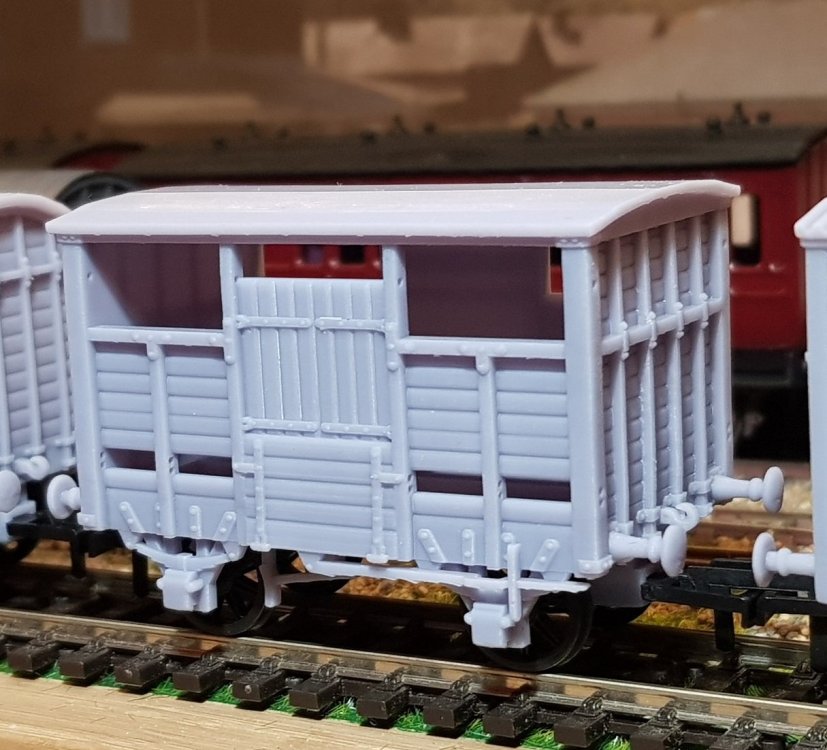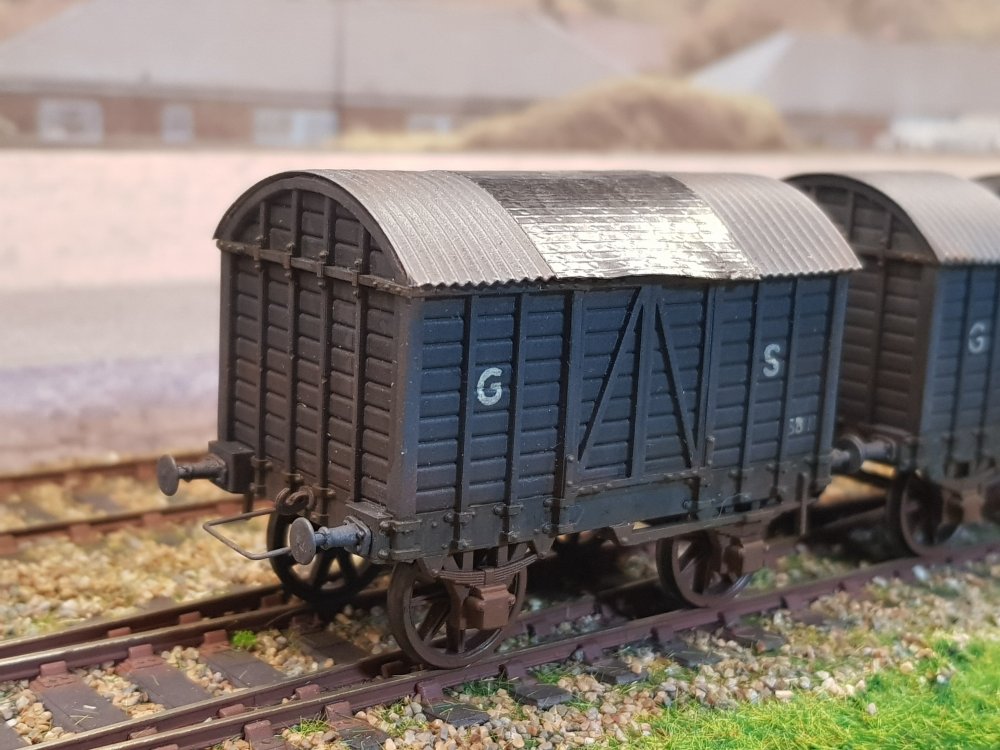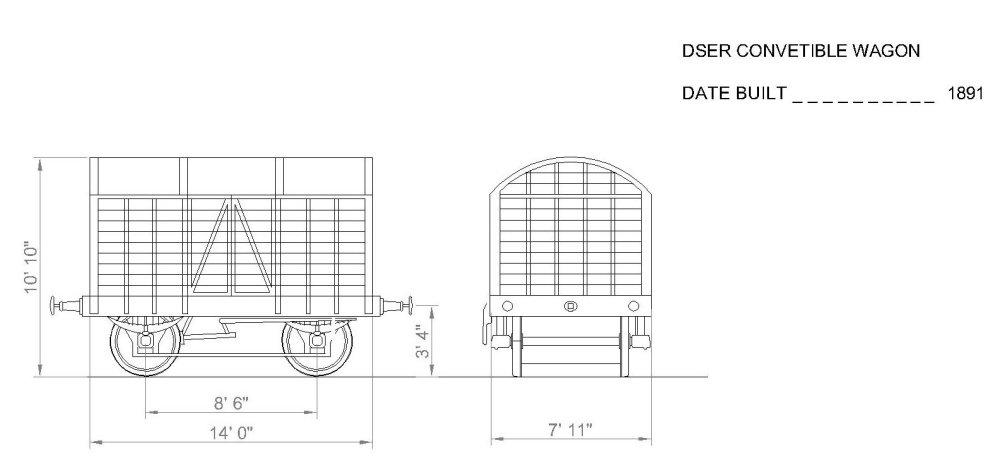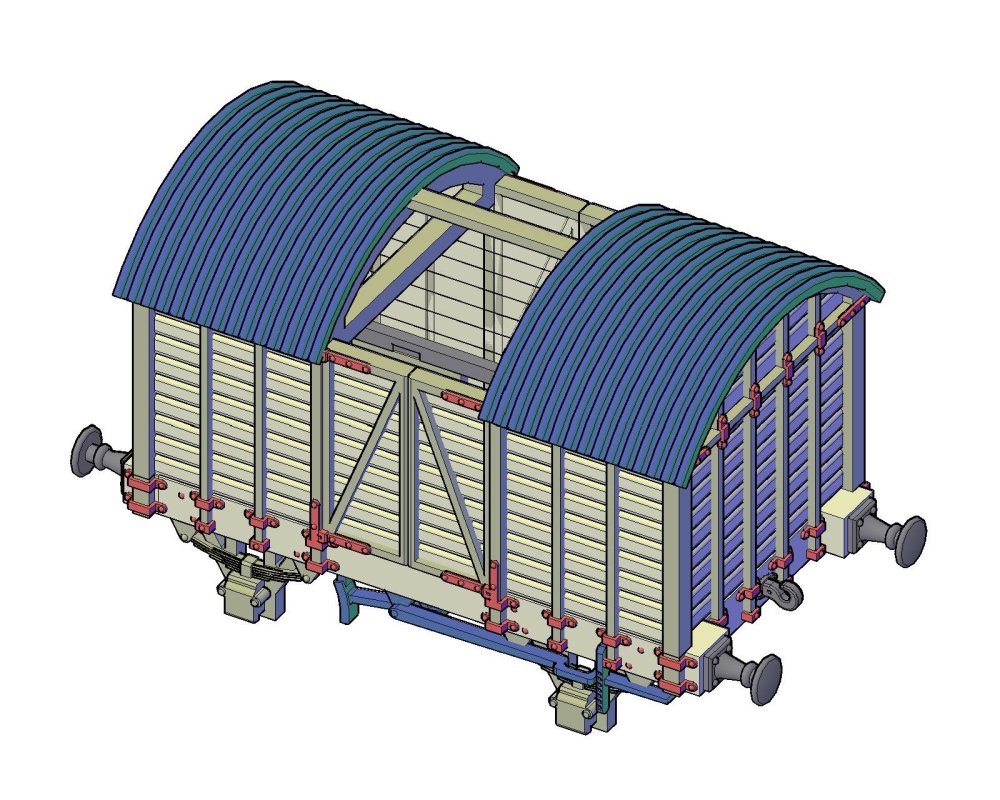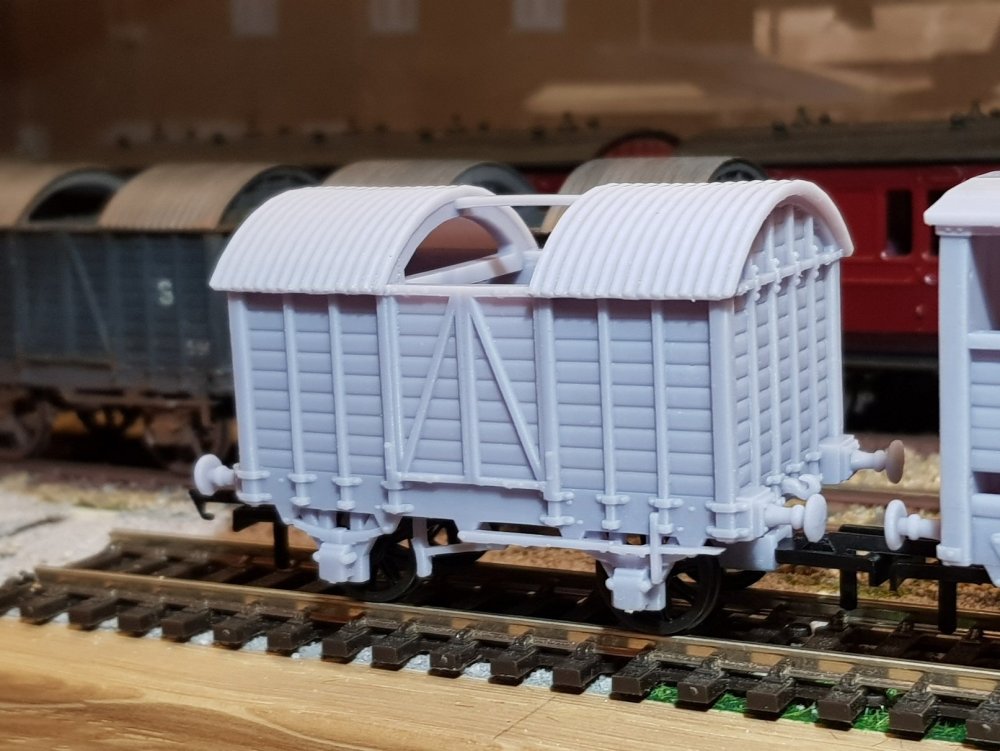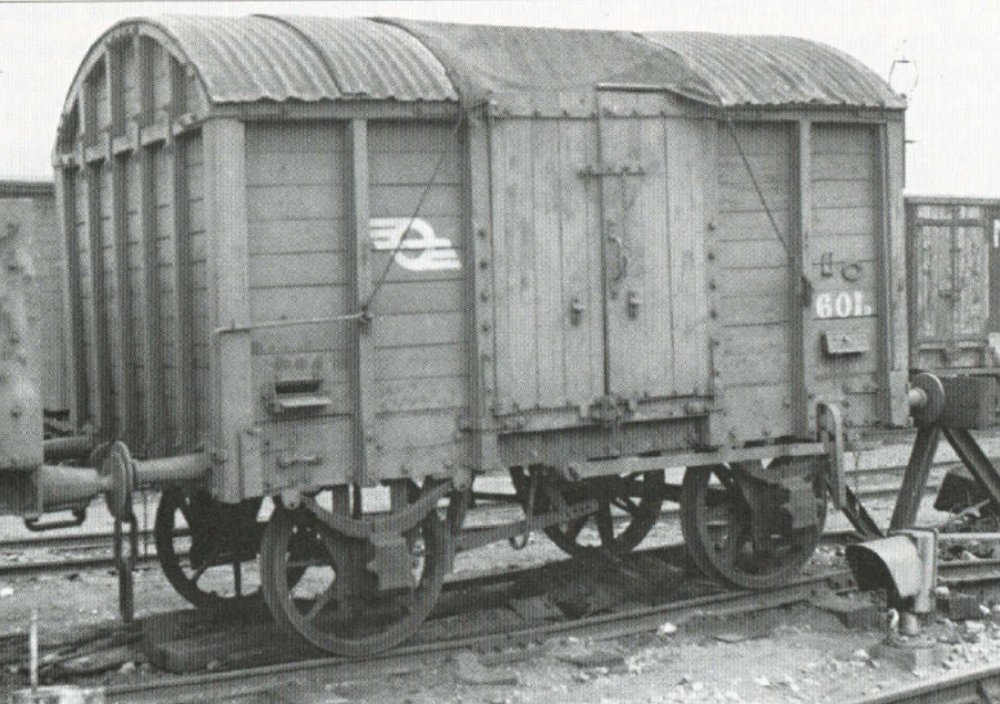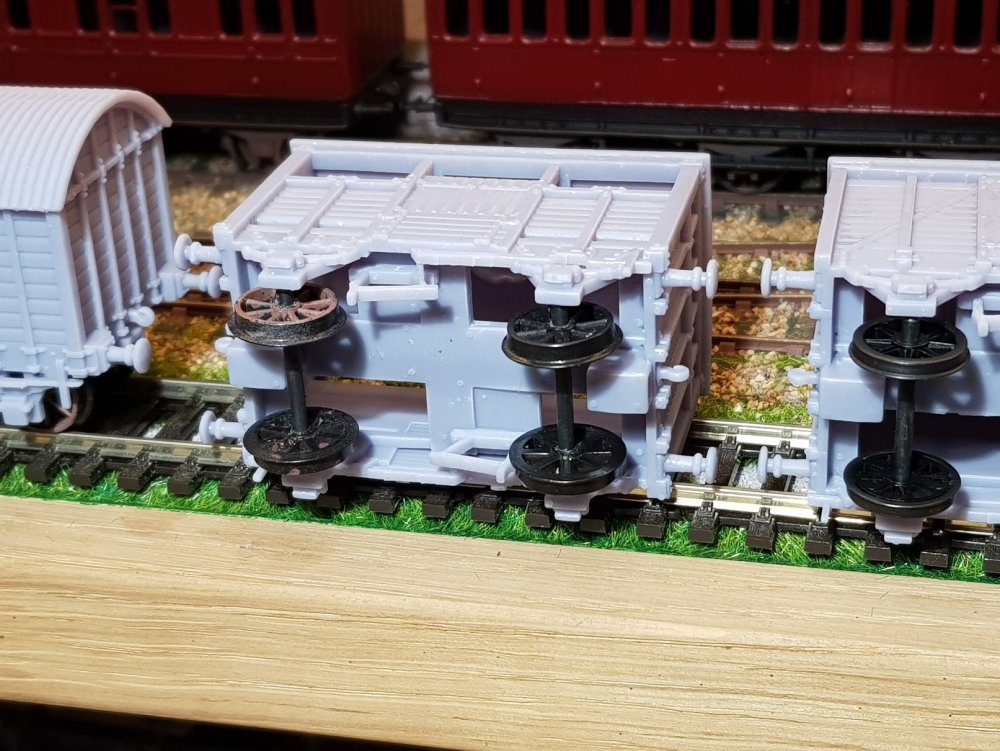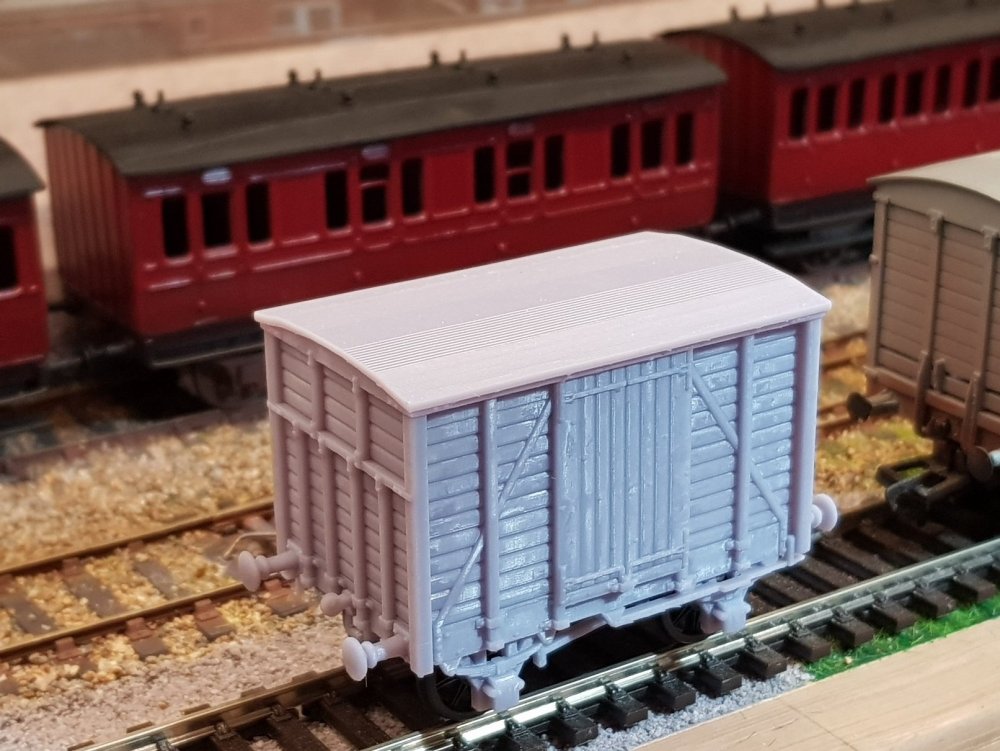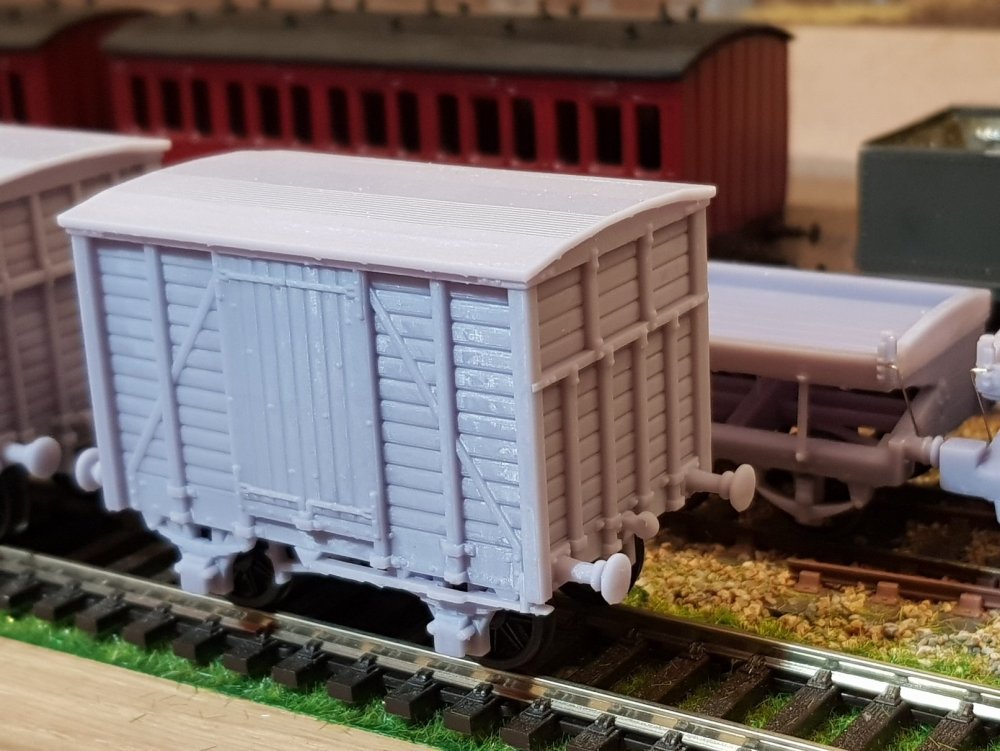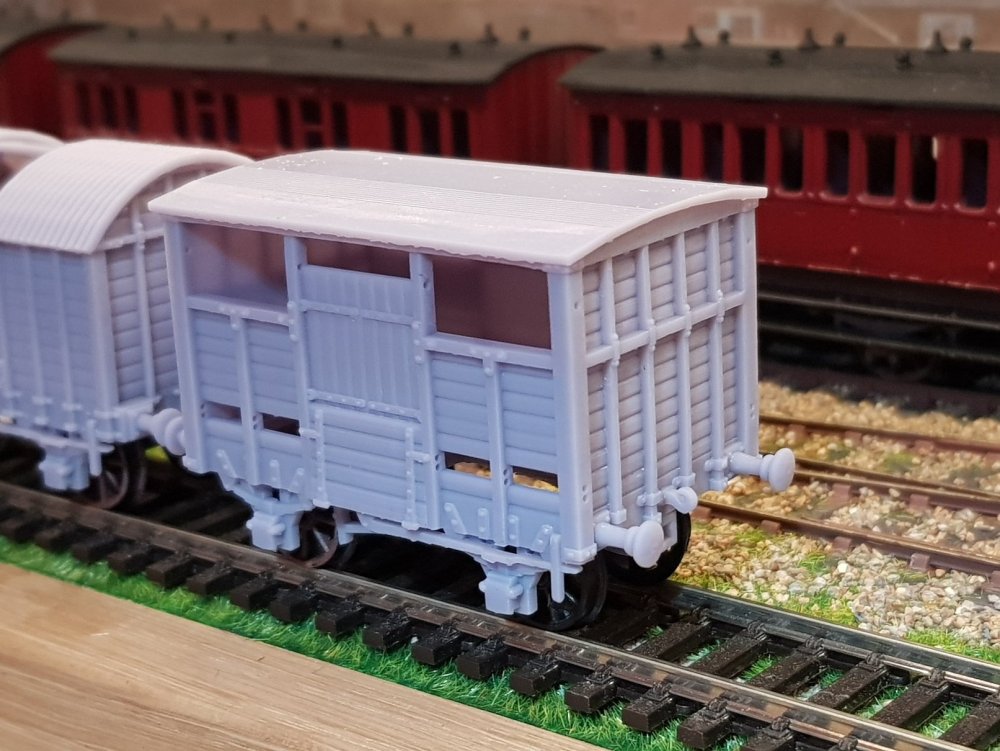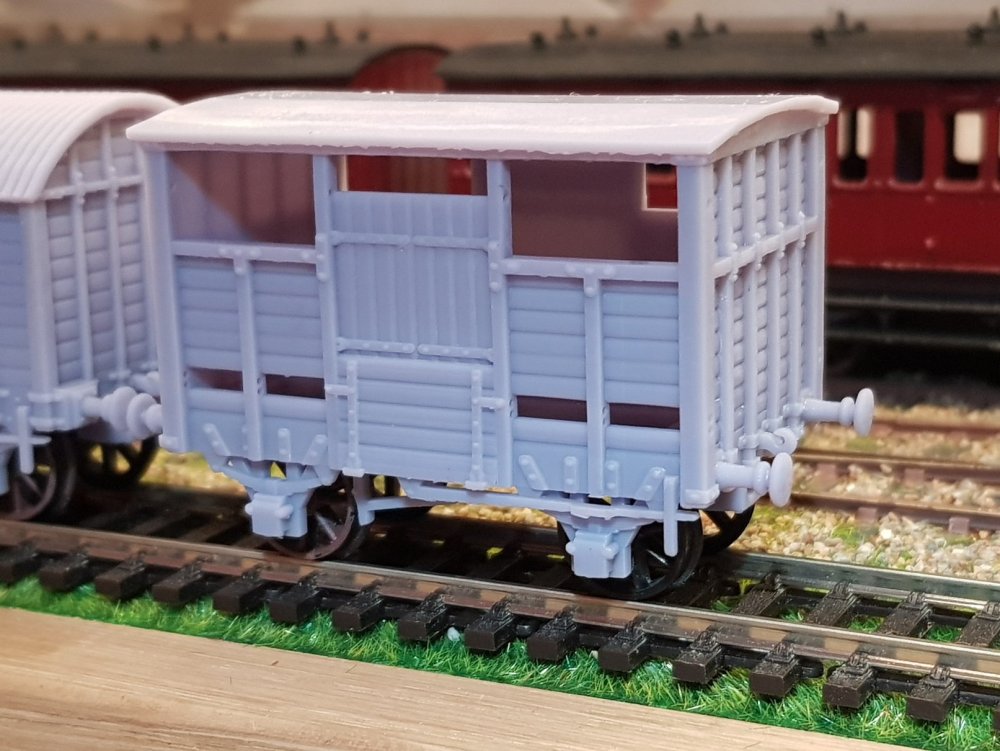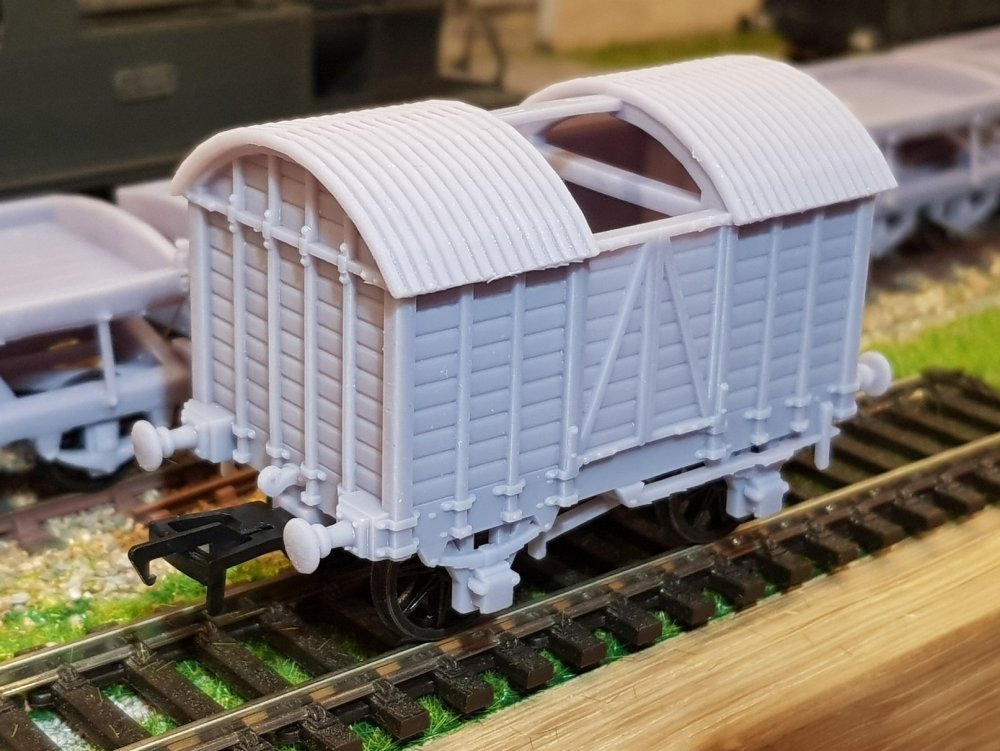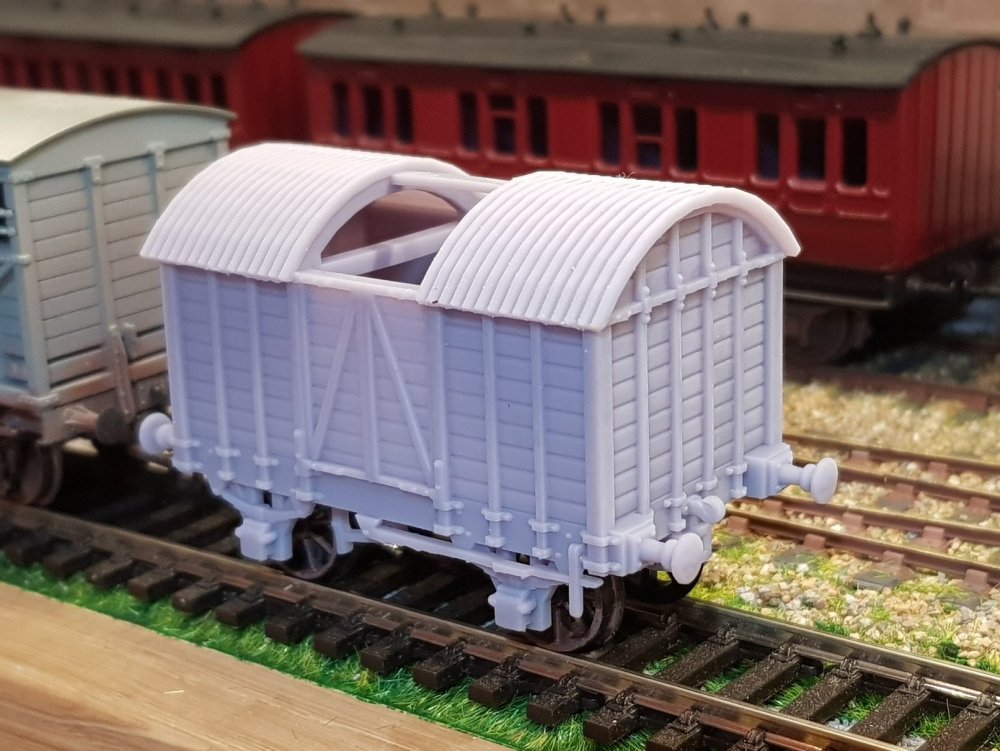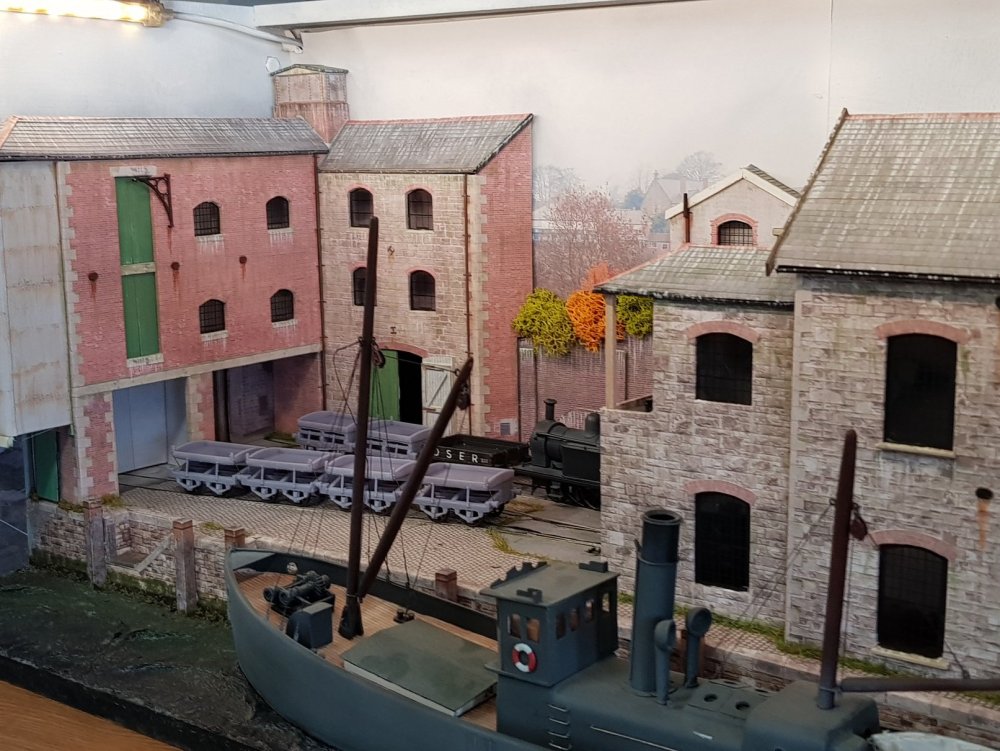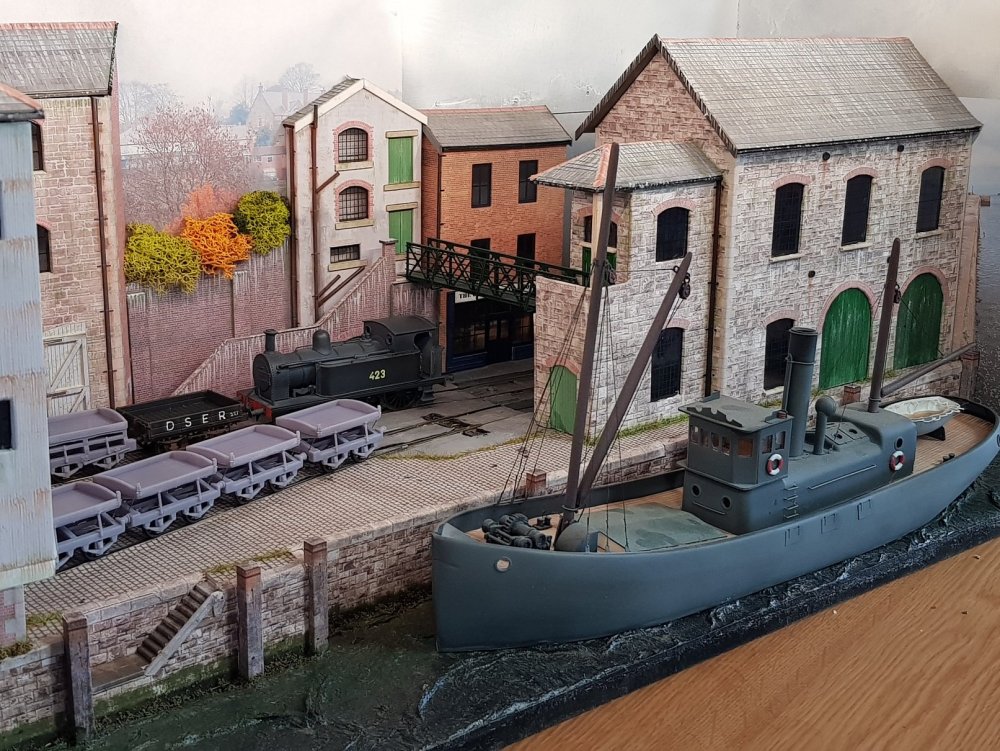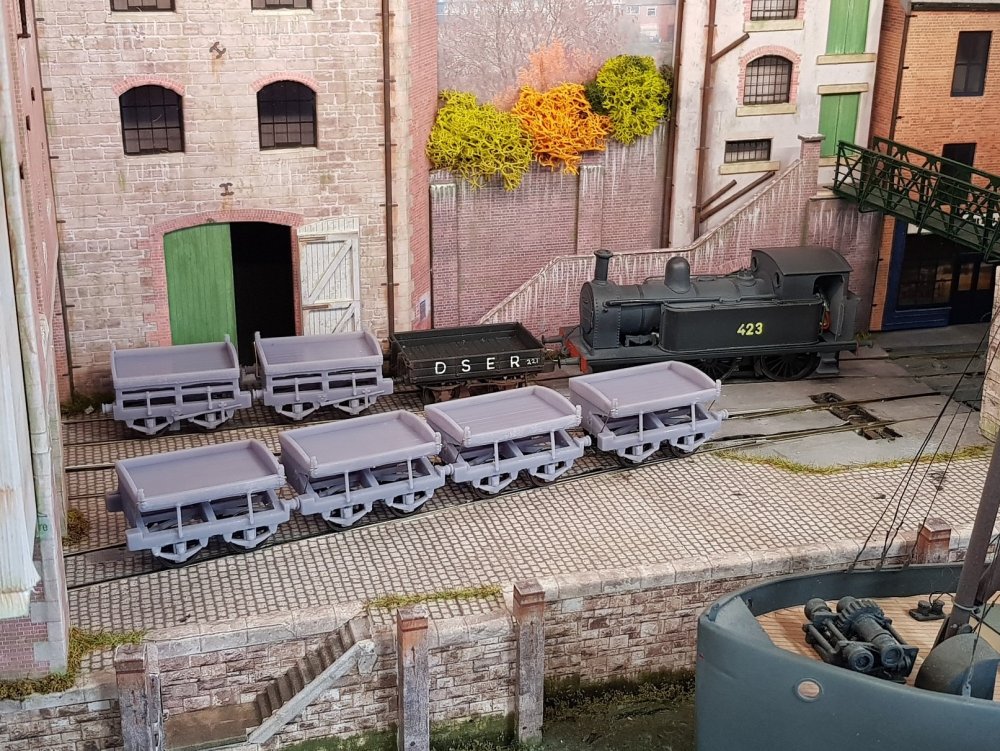-
Posts
540 -
Joined
-
Last visited
-
Days Won
29
Content Type
Profiles
Forums
Events
Gallery
Blogs
Store
Community Map
Everything posted by KMCE
-
Ok, so I think we have a print, at 4mm scale at this point. Some tests needed to 2mm and 7mm scales to see how this model will print.
-
Before separating into parts, I decided to re-print, but focus on supports for the end of the tank, and this time I think we have it. Little bit of tidy up and it should be right for painting.
-
That's a fine backhanded compliment, right there. Your work is excellent - no need for the modest blushes. To be honest, it never occurred to me, not being of the book writing type. If I were to do a book it would be quite far off in the future! In the interim, if you would like drawings of any particular wagon, just drop me a PM & we will see what we can do. The outline drawings I have provided can be annotated further - I limit the amount of dimensions, as to add to much would obscure the drawing, particularly when viewed on the forum here. It is not my intention to hide these drawings or secret them away, as given the lack of information on the DSER, it would be remiss of me not to allow my limited research to a wider audience. Drop me a note if you want to discuss further. Ken
-
For those following the section in the manufacturers area on the gas tank wagon, I noted that I would be running some prints to establish how well the would print. Rather that clog that topic, I felt I would update progress here, as I'm not entirely happy with the print result thus far. The wagon has turned out rather well, and I quite like the open chassis look and feel. There are some striations to the tank body and ends due to the curves, so some tweaking to the slicing software may be needed to smooth this out a little better. As anticipated, supports for the tank proved problematic, particularly with the NEM pocket as it blocks access to the underside of the tank ends. The tank ends were un-supported and thus sagged away - it's not major, but takes away from the tank which is the key feature of the wagon. I may be able to get some intermediate supports between the NEM pocket & underside of the tank - a little more work in getting them out post print, however it's worth a try. The provision of holes on the underside of the tank did work out well, allowing uncured resin out. This should provide a good basis for adding weight in the form of sand / ballast & plugging the holes with wax or similar. A little more work & hopefully we can get better results. All for now, Ken
- 379 replies
-
- 10
-

-
- 1 reply
-
- 7
-

-
Lighting in passenger coaches on the DWWR system was originally by oil lamps, and in 1878, the company began testing various manufactures offering of gas lighting systems, one of which was the system used by the MGWR. In 1884, the Pintsch Gas Company lighting system was installed in coaches free of charge and utilised their patent compressed oil gas – quite a deal at the time and one can only wonder at the discussion around gas costs over the years. To facilitate the change, a gas works was constructed in Bray which fitted out the coaches over time as they passed through the works, installing gas tanks with pipework up to the gas lamps located on the roof. This work continued until all coaches were converted by c. 1890. To facilitate the filling of the gas tanks on the coaches, a supply and distribution network was required to bring the gas to the coaches. To this end two gas tank wagons were constructed to facilitate this distribution across the DWWR network – one wonders how the coaches were topped up before these wandering gas tankers. It would be not unreasonable to suppose the coaches were topped up in Bray when there - given the vast bulk of the coaching stock would have been on the commuter line between Bray and Harcourt St. or Westland Row. Other stock probably was topped up when possible, but it cannot be too hard to imaging a number of dark journeys when the gas ran out before Bray. Having traveled the line myself for years in the late 1980’s I do recall a number of trips when the lights failed – the tunnels South of Bray are quite dark, I can tell you! To ease the re-fuelling process, two old wagons which were possibly cattle (or open) wagons were stripped and their chassis used to carry tanks for the gas and re-numbered Nos. 131 and 242 . Tanks were fabricated, and given the weight of gas, these were not very heavy wagons with a reported weight of 3 tons. Notwithstanding the cobbled together approach, these wagons appear to have been quite long lived with 131 operating on the network up to 1959. One element of speculation was whether these wagons had a floor or not. In one or two partial images I have seen it looks like there was no floor and the tank cradle was built onto the wagon frames – it’s quite difficult to see however. No drawings, or even full photos were available, so by researching through old photos on various forums, (the IIRS archive online being very useful) it was possible to get some partials images which allowed a wagon to be developed and built. There is a distant image of what appears to be one of these wagons in Bray in Shepherd & Beesley (Dublin & South Eastern Railways) p61. The cattle chassis from the era in question would have been short, so a wagon length of 14" was selected, which in turn dictated the size of the gas tank. This drawing was initially developed to scratch build a brass model which after a pleasant afternoons work, plus some painting and finishing yielded a rather nice little wagon. Some elements were not quite right, however I'm happy with the result and it does look well in a rake of goods wagons, or tacked on to the back of a passenger train. I revisited the drawing and developed it up to 3D with a view to printing, and in this instance I decided to go with the no-floor option as it should make for a very interesting wagon. So, as a 3D model, we get something like this: This wagon has not been printed yet & some issues with supporting the tank during printing will need to resolved, as well as allowing un-cured resin out from inside the tank. I decided to include two 3mm holes in the underside of the tank which will facilitate resin removal, but will also allow re-filling of the tank with weight. This wagon will be very light and the open chassis will not allow addition of weight underneath, so being able to re-fill the tank with weight & seal the holes should improve the handling. Given the open frame nature of the model, it does not make sense to leave the W-Frames, axleboxes and springs as an option as it will be quite difficult to create a robust independent framing system without impairing the open chassis. I may be incorrect here, and if others wish these to be left off, I leave the challenge with them. Similar to other models this will be offered with various options: Basic body only Add: Brakes Buffers Drag hook NEM coupling pocket (OO gauge) Planned Prices: Planned Prices: N-Gauge / 2mm: € 12 - € 15 OO / P4 Gauge: €50 - €55 O-Gauge / 7mm: € 90 - €95 Ken
-
In 1885 the Parnell Quarry at Rock Big, Arklow was opened by Charles Stewart Parnell initially to produce paving stones for the Dublin Tramline. It appears some of this material was exported to England and a light rail system was installed from the quarry to the quay in Arklow to move product directly to the port for onward shipping to England. At some point the company purchased its own fleet of wagons which were also used for transport on the DWWR network from 1896 to move product for use in Ireland. These private wagons were bought (or rather sold by Parnell Quarries) by DWWR in 1899 when work in the quarry appeared to decline. Perhaps this may have been a hiatus, as the quarry has continued in use up to this day. 12 of these wagons made it through to DSER, GSR and on to CIE, so were quite long lived. Image courtesy of Shepherd & Beesley It is unclear who manufactured these wagons and no drawings exist that I am aware of, so some interpretation was required to develop a model. Using the photo and known dimensions of similar wagons of this era it was possible to establish general dimensions. As this appears to be a falling side wagon, it is reasonable to assume the heads were fixed and there appears to be a ghost of uprights in the image to confirm this. This helped to develop an outline drawing: This drawing was initially developed to scratch build a brass model and a CAD/CAM file was prepared to cut the brass on the CNC mill. With much work, this was developed into a completed model. These proved to be successful models and are a nice addition to a layout & I decided to develop them further for 3D printing. These wagons are to go to the print shop this week, so hopefully there will be post print updates later. The model will be offered with various options: Basic body only Add: W frames, axle boxes, & springs Brakes Buffers Drag hook NEM coupling pocket (OO gauge) Planned Prices: N-Gauge: € 9 - € 12 OO / P4 Gauge: €40 - €45 O-Gauge: € 80 - €85 All costs will be exclusive of shipping costs which can be determined at the time of sale and will be based on actual cost where applicable. Hope this is of interest, and if so, please reach out by PM Ken
- 1 reply
-
- 5
-

-
In 1872 the DW&WR ordered 40 open wagons, 20 of which were from the Metropolitan Railway Carriage & Wagon Co (MCW). In April of the same year a broken drawbar on a goods train caused a derailment at Foxrock which led to the introduction of side coupling chains. Whether these two events were interrelated is not clear, however from the drawing information I have no side chains were designed into the MCW wagons, so perhaps these were ordered before the incident. The Historical Model Railway Society (HMRS) has a drawing for this 3 - plank wagon produced by MCW which is annotated that it was for the DW&WR. The information provided on the drawing is very good, albeit a little smudged, however still in good condition for 150 year old drawings. A digital copy of the drawing was purchased with the view to creating a model. This drawing was imported into CAD and drawn up, however some inconsistencies between figured dimensions and drawn information needed to be resolved. I opted to use the figured dimensions and the drawings were amended accordingly - nothing major, but worth tidying up nonetheless. The wagon has a 9' wheelbase with a load area of 15’ 0” x 7’ 1”, so quite a large wagon for the time of construction. The earlier design provenance can be seen in the extended headstocks which look similar to dumb buffers. In line with other wagons of this era, brakes or in this instance – brake, is on one side only. Given the single brake arrangement, it is reasonable to assume these were coupled in one direction & thus brake levers would be on one side of the train in any given rake to allow banksmen to secure the train without recourse to crossing the train. These wagons were re-built in 1907 in the Grand Canal Works which transformed it completely from this characteristic wagon. The re-built version had 4-planks, almost flush doors, with door planks vertically instead of horizontally. There is an image of the re-built version in Shepherd & Beesely “Dublin & South Eastern Railways” page 107, which I will not reproduce here as it is distinctly different from this wagon. I have not been able to uncover any photos of this wagon to date, so we will have to make do with a model at this time. A 3D model was developed from the drawings above to allow printing. This printed quite well, and in OO Gauge with options we get: As noted with other models, the wagon is available in various options - for example the model below is printed with chassis & brakes only and has been developed in P4 finish to 21mm with buffers, drag hook, couplings and P4 wheels added separately. The wagon has not been painted yet, so is still with a basic undercoat: The model will be offered with various options: Basic body only Add: W frames, axle boxes, & springs Brakes Buffers Drag hook NEM coupling pocket (OO gauge) Prices: N-Gauge: € 9 - € 12 OO / P4 Gauge: €40 - €45 O-Gauge: € 80 - €85 All costs will be exclusive of shipping costs which can be determined at the time of sale and will be based on actual cost where applicable. Hope this is of interest, and if so, please reach out by PM Ken
-
- 4
-

-
The 13’ 6” Ashbury wagon is probably the best know DSER wagon as there are numerous photos and some line drawings which have appeared in various publications over the years. The wagon in question here is the 1902 version built by Ashbury Carriage & Iron Co., however Ashbury did build earlier wagons for the DWWR in 1857 and again in 1878, and some of these were used for the conveyance of livestock prior to the intervention of the Board of Trade requirements for separate wagons for this traffic. There are some images of this earlier wagon being used for livestock conveyance with the upper most board under the roof being removed to allow air through the wagon. Whilst this wagon may be the best known of the DWWR /DSER wagon, it was by no means built in large numbers; the convertible wagon considerably eclipsed these vans in numbers and use across the network. These wagons were quite long lived and survived into the CIE era being modified with through vacuum piping and screw couplings to allow them run with coaching stock. Later version of the wagon were fitted with basic louvres and can be modelled as an option with these wagons. Image courtesy of Shepherd & Beesley There are some sketch drawings available for this 1902 version which were used to develop a more detailed drawing, and photos then used to clarify elements for development of a 3D model. The 3D model was developed with various options to allow printing: Prints for OO Gauge with all options excluding louvres we get: Add the louvres: Holes have been provided in the model to make it easier to install the metal rods as per prototype. As noted above, the model is available in various options - for example the model below is printed with chassis & brakes only and has been developed in P4 finish to 21mm with buffers, drag hook, roof, couplings and P4 wheels added separately: The model will be offered with various options: Basic body only Add: W frames, axle boxes, & springs Brakes Buffers Drag hook Roof Louvres NEM coupling pocket (OO gauge) Prices: N-Gauge: € 10 - € 15 OO / P4 Gauge: €45 - €50 O-Gauge: € 85 - €90 All costs will be exclusive of shipping costs which can be determined at the time of sale and will be based on actual cost where applicable. Hope this is of interest, and if so, please reach out by PM
- 7 replies
-
- 10
-

-
No layout of an Irish network would be complete without the ubiquitous cattle wagon; in some regards, the movement of cattle may have been the mainstay, or certainly a bedrock of the railways. Many versions have been made over the years by various builders, however one network’s variety has not been well represented, not that I could find anyway. The DWWR / DSER railways, like other railways had their own version. DWWR / DSER had various iterations of this wagon but prior to 1896, cattle sheep and pigs were transported across the network in covered wagons which were also used for general goods traffic. With the introduction of new regulations through the Board of Trade and Veterinary Department, it was necessary to build new wagons specifically for the conveyance of livestock. A batch of new wagons were built between 1896 to 1899 mainly to replace the old stock, however these appear to have been built without falling doors. From 1900, falling doors were fitted as standard and the wagons introduced between 1900 and 1915 were further replacements of covered wagons with the addition of 85 new wagons out of a total of 143 wagons constructed over this time. The wagons of this period were constructed mainly by Grand Canal Street, with some build by Hurst-Nelson (15 No.). My initial research has not uncovered any drawings, and only two partial photos were discovered, both from Shepherd & Beesley, (Dublin & South Eastern Railway) pages 70 & 104, so some interpretation was needed to develop and build a model. Without any drawings and only partial images, some reasonable assumptions were made, thus a wagon length of 14" was selected, with an 8’ 6” wheelbase. At this time, chassis for wagons in the DWWR fleet were generally short (13 – 14ft). Image courtesy of Shepherd & Beesley - Cattle wagon at Bray An initial outline drawing was developed with reference to the known dimension of other wagons and using information gleaned from the limited photos available. This was then developed into a 3D model for printing: As a print for OO gauge inclusive of all options, we get: Holes have been provided in the model to make it easier to install the metal rods as per prototype. As noted above, the model is available in various options - for example the model below is printed with chassis & brakes only and has been developed in P4 finish to 21mm with buffers, drag hook, roof, couplings and P4 wheels added separately: The model will be offered with various options: Basic body only Add: W frames, axle boxes, & springs Brakes Buffers Drag hook Roof NEM coupling pocket (OO gauge) So, the difficult bit - prices: N-Gauge: € 10 - € 15 OO / P4 Gauge: €45 - €50 O-Gauge: € 85 - €90 All costs will be exclusive of shipping costs which can be determined at the time of sale and will be based on actual cost where applicable. Hope this is of interest, and if so, please reach out by PM Ken
-
- 13
-

-
Probably the most numerous wagon over all railway companies was the convertible (or semi?) wagon, and like other companies, DWWR/DSER had their own version. This wagon was used on their network from 1855 and built for them by all the notable carriage and wagon companies over the years. These wagons were used for the conveyance of all goods, including livestock until the introduction of new regulations through the Board of Trade and Veterinary Department in 1896 which prescribed dedicated wagons be used for livestock. They had a long life and were used around the network until the end of loose coupled goods. My research uncovered drawings made by Metropolitan Railway Carriage & Wagon Co. (MCW) from 1891 sourced from the HMRS. This may not be a drawing of an early wagon as MCW were building these wagons for DWWR from 1863, however it could be seen as a development from their earlier wagons. These wagons were small with an 8’ 6” wheel base and 14’ over the body. Height wise, they were noticeably lower than other stock at c. 10’ 10”. Image courtesy of Shepherd & Beesley of 1920's rebuilt convertible wagon. An initial outline drawing was developed from the drawing correcting discrepancies between the figured dimension and drawing – nothing major, but good to tidy up. This has been developed into a 3D model As a print for OO gauge inclusive of all options, we get: As noted above, the model is available in various options - for example the model below is printed with chassis & brakes only and has been developed in P4 finish to 21mm with buffers, drag hook, roof, couplings and P4 wheels added separately: The model will be offered with various options: Basic body only Add: W frames, axle boxes, & springs Brakes Buffers Drag hook Roof NEM coupling pocket (OO gauge) So, the difficult bit - prices: N-Gauge: € 10 - € 15 OO / P4 Gauge: €45 - €50 O-Gauge: € 85 - €90 All costs will be exclusive of shipping costs which can be determined at the time of sale and will be based on actual cost where applicable. Hope this is of interest, and if so, please reach out by PM Ken
-
- 8
-

-
So the mods have been good enough to give me my own sandbox to play in & I thought I would put it to good use. There has been quite a bit of interest in the models I have developed over the recent past, and some have even ventured far enough to put cash money on the table for some of my models - you know who you are, and many thanks. This is the first tentative steps into providing a source of models in various scales, and initially will be for DWWR / DSER rolling stock, and who knows, perhaps some kits for locos in the future. The DWWR / DSER were one of the big four operating on the Island prior to amalgamation, however a huge amount of information has been lost over time. Finding information has proved difficult, and some of the models offered here will be interpretations of what the particular stock would have looked like as best as can be ascertained from the information available. In these instances I will clearly indicate where interpolation has been used to fill in the gaps, so bear with me. If anyone can provide amplifying or clarifying information on the assertions I put forward, I would be glad to hear from them. The goal here is to provide the most accurate historical information possible - oh, and to create some models on the way. At this point, I propose to provide 3D models printed & cured, but not finished to allow the modeller finish them as they wish. These models will be available in various guises depending on what is required - basic will be body only, additional options will be chassis, brakes, buffers, drag hooks, roof, and NEM pocket for OO Gauge. This is not intended to be an exercise in adding costs, more a case of allowing modellers to chose what they want. Some kits may be provided as brass etches to allow modellers build the model themselves and will be similar to other etch kit solutions. I propose to create a new topic for each of the models which will include information on the history of the model, details on what options are available (including scales) as well as put some ideas of costs as best I can. A this point it will probably be best to contact me directly through PM if you want to order anything & we can take it from there. OK then, here we go..... Ken
- 14 replies
-
- 17
-

-

-

-

-
-
JB Very nice. This is from an Ashbury built covered van like this: Courtesy of Shephard & Beesley. Or this, in its model form: Not sure where these plates would have been located on the prototype, as they would be visible in the top photo. Perhaps they were located around the buffers? Odd location if so? Ken
-
Angus, Your work with the models is really superb & they have come out really well. I was a little concerned they may be sub par, but looking at what you have done with them, I don't think I need to worry. Delighted to see how these have progressed. Ken
-
Many thanks for the kind comments. Wagons have a floor, well kinda. To help reduce suction and risks of misprint, I have broken the floor down into a stepped cross shape. This provides additional strength & also helps to reduce the area of resin stuck to the FEP, thus reducing the risk of tear away from the model. Large flat areas can cause problems where there is not enough adhesion between the previous layer and the layer just printed - this can cause separation in the layers. Poor case is a de-laminated model, worst case is it separates from the model and prevents any further printing. These openings can be closed over, but it does allow access to the interior of the wagon to add weight - these wagons are light and will need something added. There is enough space to add lead, and perhaps some cattle for the cattle wagon - so long as they are slim cattle!! Ken
-
They are OO scale! I will supply 28mm pinpoint axles - wheels are up to you. Thus you have the option of OO or 21mm, which ever you prefer. Ken
-
I'm looking forward to see those run with your stock (no rush like!!!)
-
Some upgrades to the wagons: Buffers & hooks added. Roofs (different types) fixed in place, and for those OO gauge people - NEM pockets. Some OO gauge wheels added for photos. Ashbury 13'6" van. Convertible wagon with NEM coupler Cattle wagon - brass rod to be added to represent cross bars, however holes provided to ease installation. No work has been done to these wagons with the exception of adding wheels - these are literally hot off the UV curing table. Some minor tidying up of edges & support spots to be removed. The curved roofs could do with a quick sand to remove the print lines. Few issues to address: - Buffer collar behind head is too large and needs to be tweaked to reduce size slightly. - NEM pocket is slightly too high, but again this will depend on what wheels are used. Cattle & Convertible are designed for 3'6" wheels (as per prototype) and pocket will definitely need to be moved down. Not as big an issue if 3' wheels are used. Quick shot of these wagons in a small rake. Getting to a point where these can be supplied on demand if they are of interest. All for now..... Ken
- 379 replies
-
- 12
-

-

-
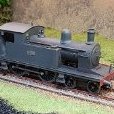
Ernies Massive Irish 1930's to 2005 Photo Archive
KMCE replied to Glenderg's topic in Photos & Videos of the Prototype
That makes sense - thus the bunker tank is wrap-around in effect making one large tank out of all tanks. That would take some time to fill!! -

Ernies Massive Irish 1930's to 2005 Photo Archive
KMCE replied to Glenderg's topic in Photos & Videos of the Prototype
That photo of Lough Erne taking on water got me thinking. I know the side and bunker tanks were connected as you can regularly see the connecting pipe under the foot plate behind the cab ladder. Were the tanks on both sides of the loco connected allowing filling from one side only? Ken -
Nice to see your progress on this one. I particularly like your sketch of how the model will look - nice idea which will help to keep the overall picture in mind. The discussion on low relief buildings is most interesting and is something that I find a little difficult to incorporate into my layouts. The buildings and backscenes on Fintonagh are superb example on how it should be done. I guess I just need more practice!! More power to your elbow, as they would say....
-
Ore wagons made it down to the port. Still in works grey though! As seen at the fair on Sunday (14th November 21) Ken
- 71 replies
-
- 13
-

-

-
Something very satisfying about a coupled loco rolling well.
-

Ernies Massive Irish 1930's to 2005 Photo Archive
KMCE replied to Glenderg's topic in Photos & Videos of the Prototype
I used to walk through that pedestrian tunnel (on the right above) a couple of times a day back in the early 90's. Pedestrian tunnel was always clean and well lit, whilst the railway tunnel was kinda dark, damp, and cold. Impressive to walk through the full rail tunnel - quite a long walk around the spiral though!! It was possible to see between levels at some points where holes had developed (or made for new cabling) close to the walls - thickness of the floor was thinner than I would have expected . Thanks for the photos, Ernie - that brought back some memories.....
.png.c363cdf5c3fb7955cd92a55eb6dbbae0.png)

